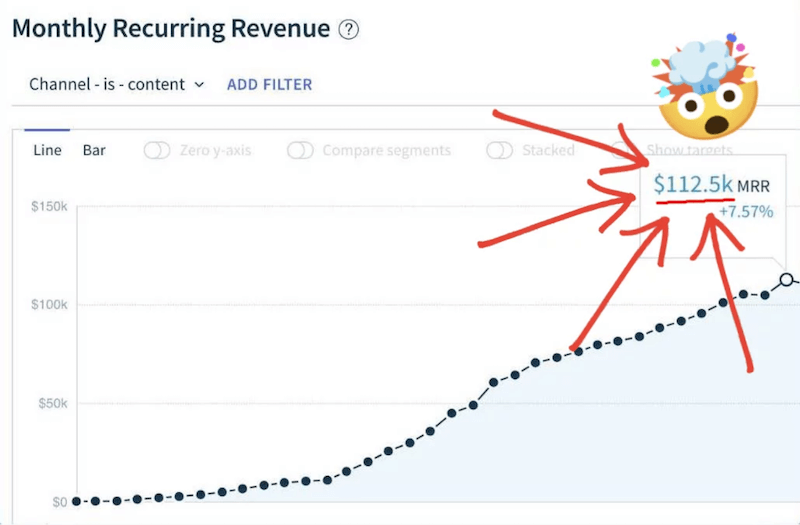Bonus Material: Free Content Distribution Checklist
In 60 days, I used the content distribution strategy in this post to get 87,591 visitors to one blog post.
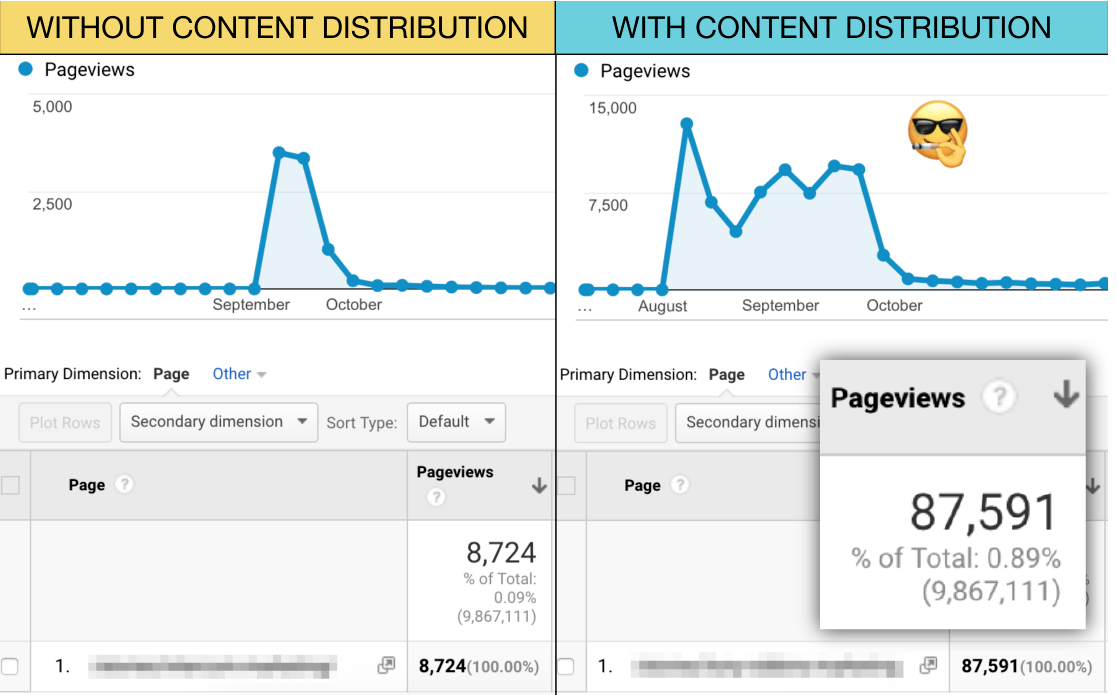
And once I was done I started getting a consistent flow of ~500 visitors flooding in EVERY week.

Note: The amount of ongoing traffic you get will vary based on the topic of your content. Topics searched more often will get more organic SEO traffic.
Today I’m going to show you exactly how I did it.
(step-by-step)
Grab my content distribution checklist below to see how it works.
Then use my methods to promote your blog posts, videos or podcasts.
Don't have time to distribute your content?
Our partners Repurpose House can turn any piece of content you have (blog article, video, pdf, or podcast) into different sized videograms, thumbnails, image quotes, and promo images for Facebook, Instagram, Twitter, YouTube stories, and more.
Use discount code CONTENTMAVERICKS to get 10% off your first month.
Let’s jump in!
The Content Distribution Flywheel: 3 Steps To Exponential Traffic Growth
There are two types of traffic growth. One is linear, and one is exponential.
Linear is what 99.99% of website traffic growth is. Most businesses can’t even pull it off. With linear growth to get 10x as much traffic, you need to spend 10x as much on ads (or produce 10x as much content.)
With exponential traffic growth sometimes you don’t need to spend any money on ads or produce any more content, and you get 10x more traffic.
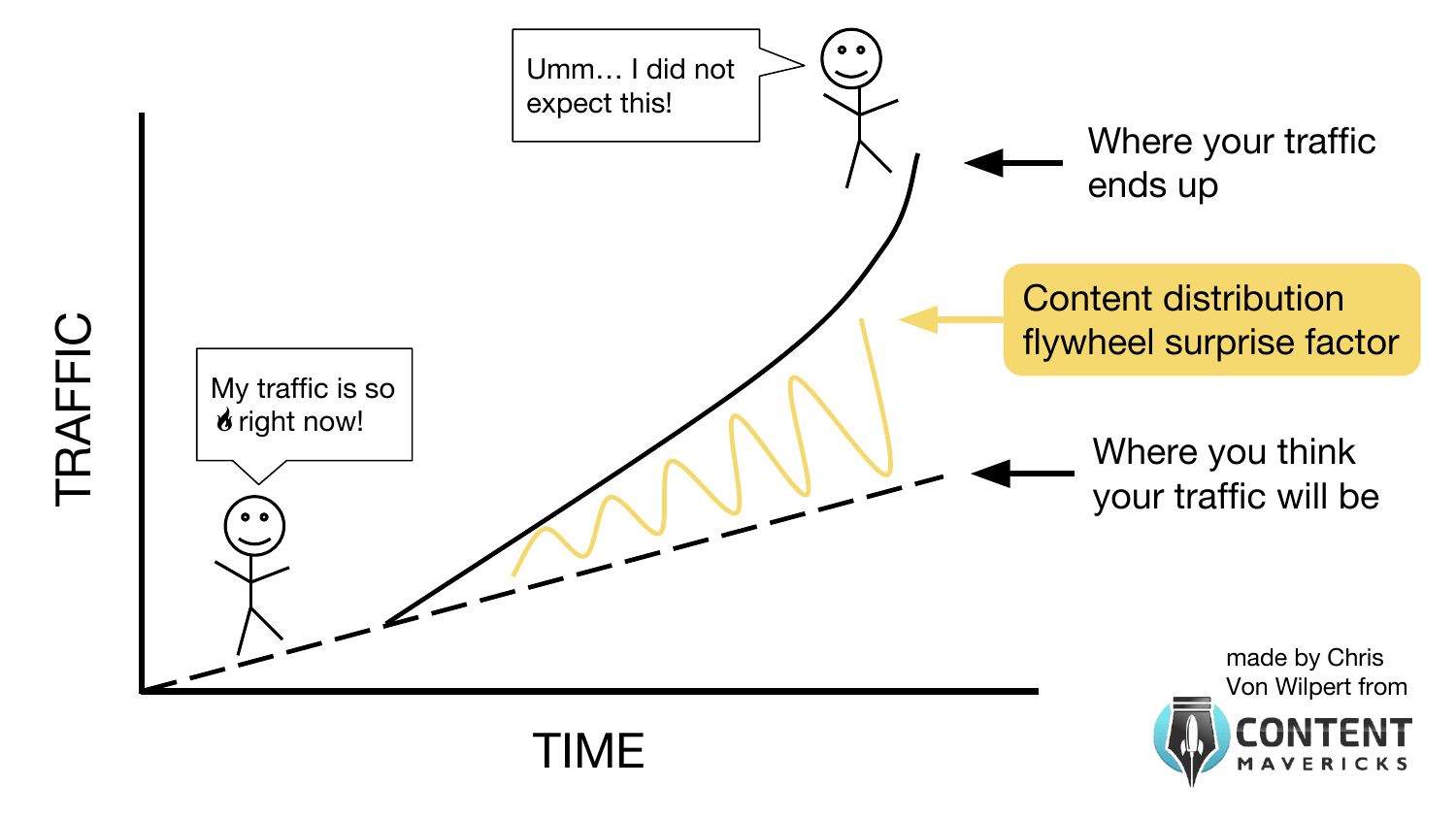
It took me a long time to figure out how exponential traffic growth works.
I found that to do it, you need to have a content distribution flywheel (not a funnel).
Here’s what that looks like:
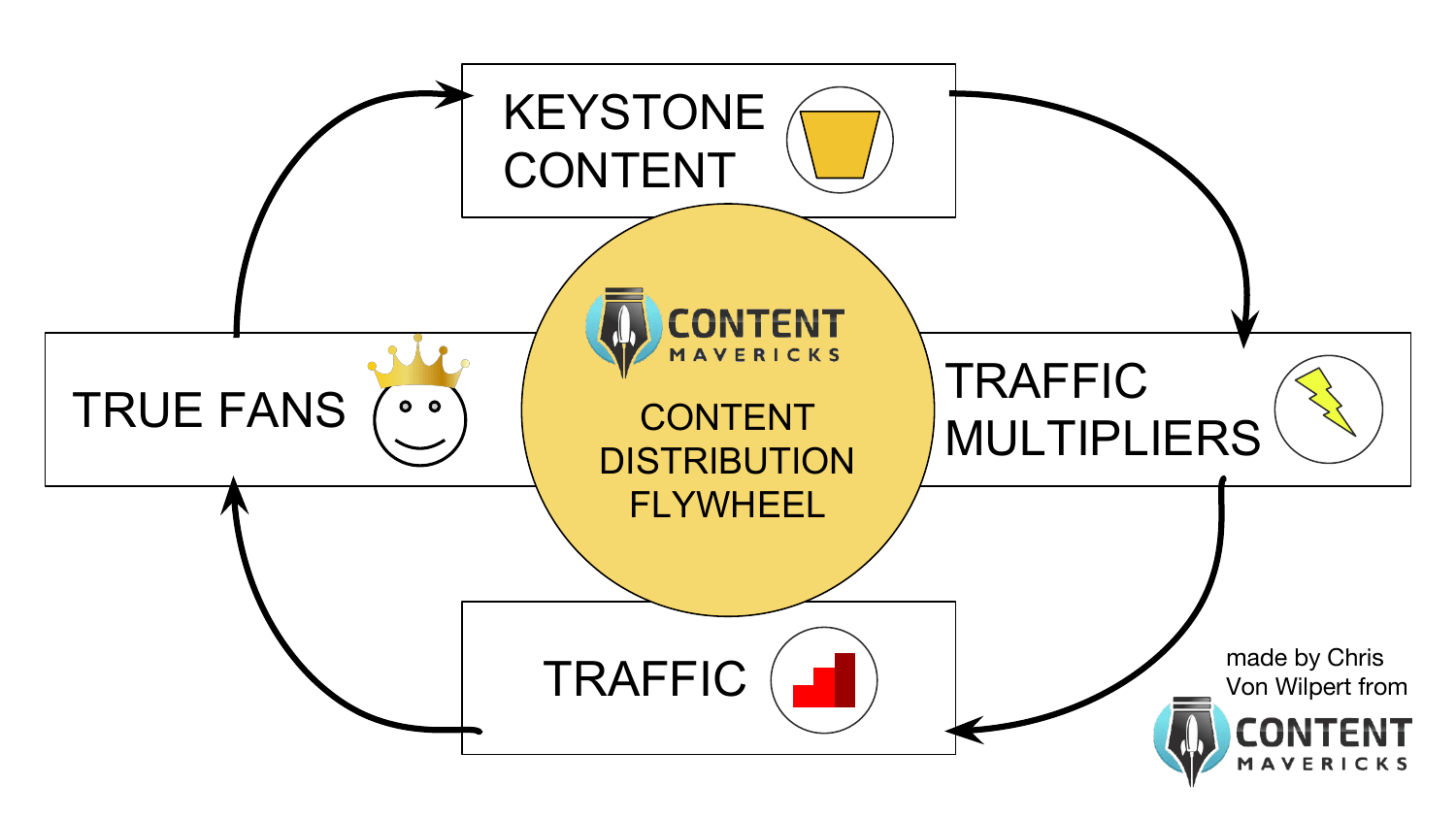
When you’re starting out, the flywheel takes time to build.
But if you follow the process I show you below, you’ll end up with more traffic going to your content than you ever expected.
The 3-Steps To Using “The Content Distribution Flywheel” To Get Exponential Traffic
There are three steps to create a content distribution flywheel.
Step 1: Build an audience of true fans using your Greatest Hits content, social media supernode, and the big dawg level-up technique.
Step 2: Use free traffic multipliers to get thousands of free clicks from fans hungry for content on your topic.
Step 3: Use paid traffic multipliers to manufacture virality, amplify your top performing content, and reach thousands of new fans.
Most companies fail at content distribution because they publish content, then promote it to:
- No audience OR
- An unengaged audience.
Then they wonder why content marketing doesn’t work (like my friend Freddie).

Look at all the successful people and companies who’s #1 channel is content marketing: Buffer, Drift, Justin Brooke, Gary Vaynerchuk, Tim Ferriss, Seth Godin, Julie Zhuo, Jason Fried, Dharmesh Shah, Nerd Fitness, etc.
They all build ENGAGED audiences they can distribute their content to.
Here’s how you can do it:
Step 1: Build An Audience Of True Fans Using Your Greatest Hits Content, Social Media Supernode, And The Big Dawg Level-Up Technique
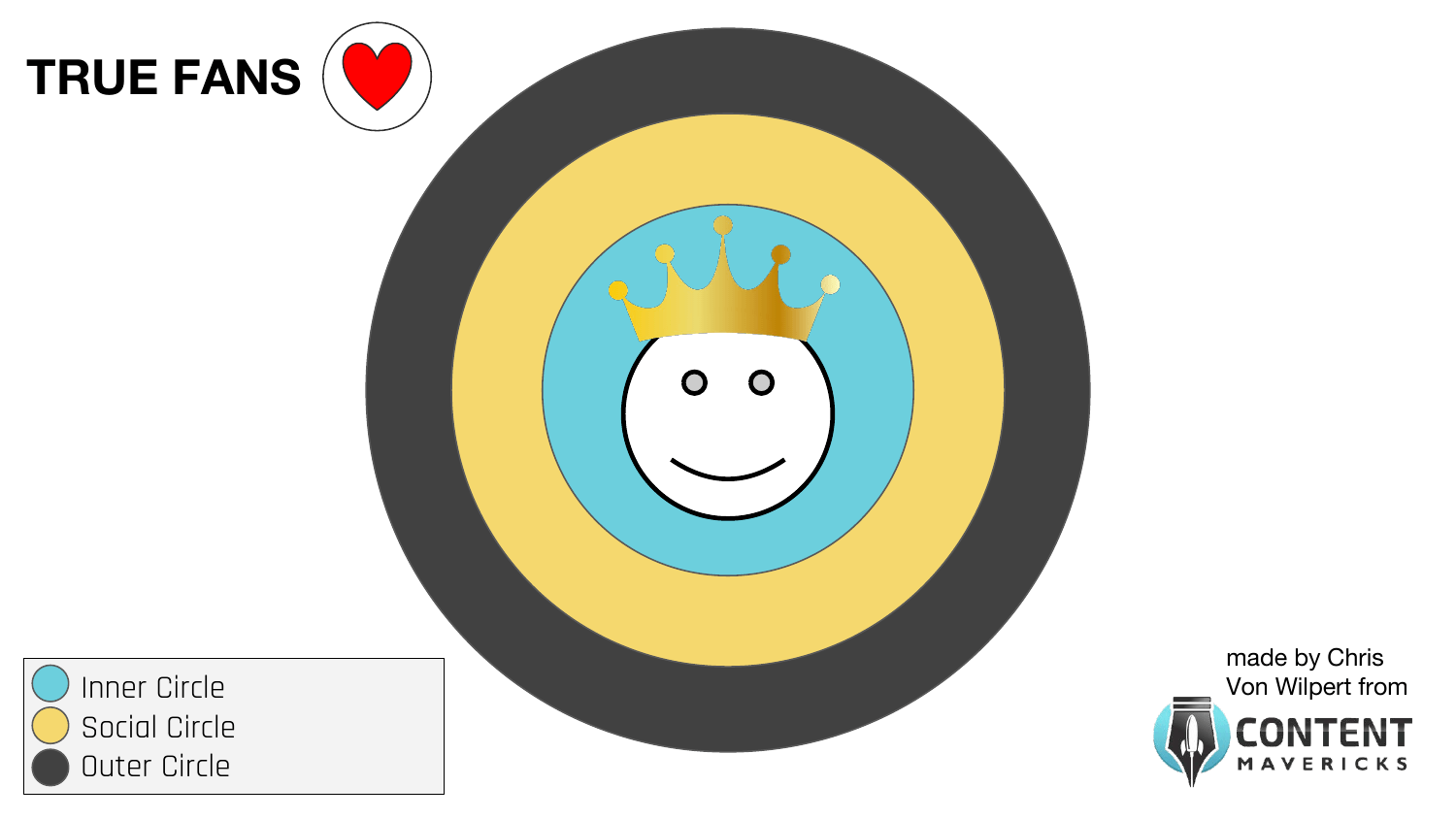
Inner Circle
Your inner circle are the true fans that:
- Subscribe to your newsletter.
- Read every single word.
- Click every single link.
- Send it to ten of their friends.
They pay attention to everything you put out, and value your work so much that they are willing to pay for anything you sell.
In an era of information overload, with content managers who try to consistently churn out content to impress their boss, it is rare to ever develop this sort of relationship with a fan.
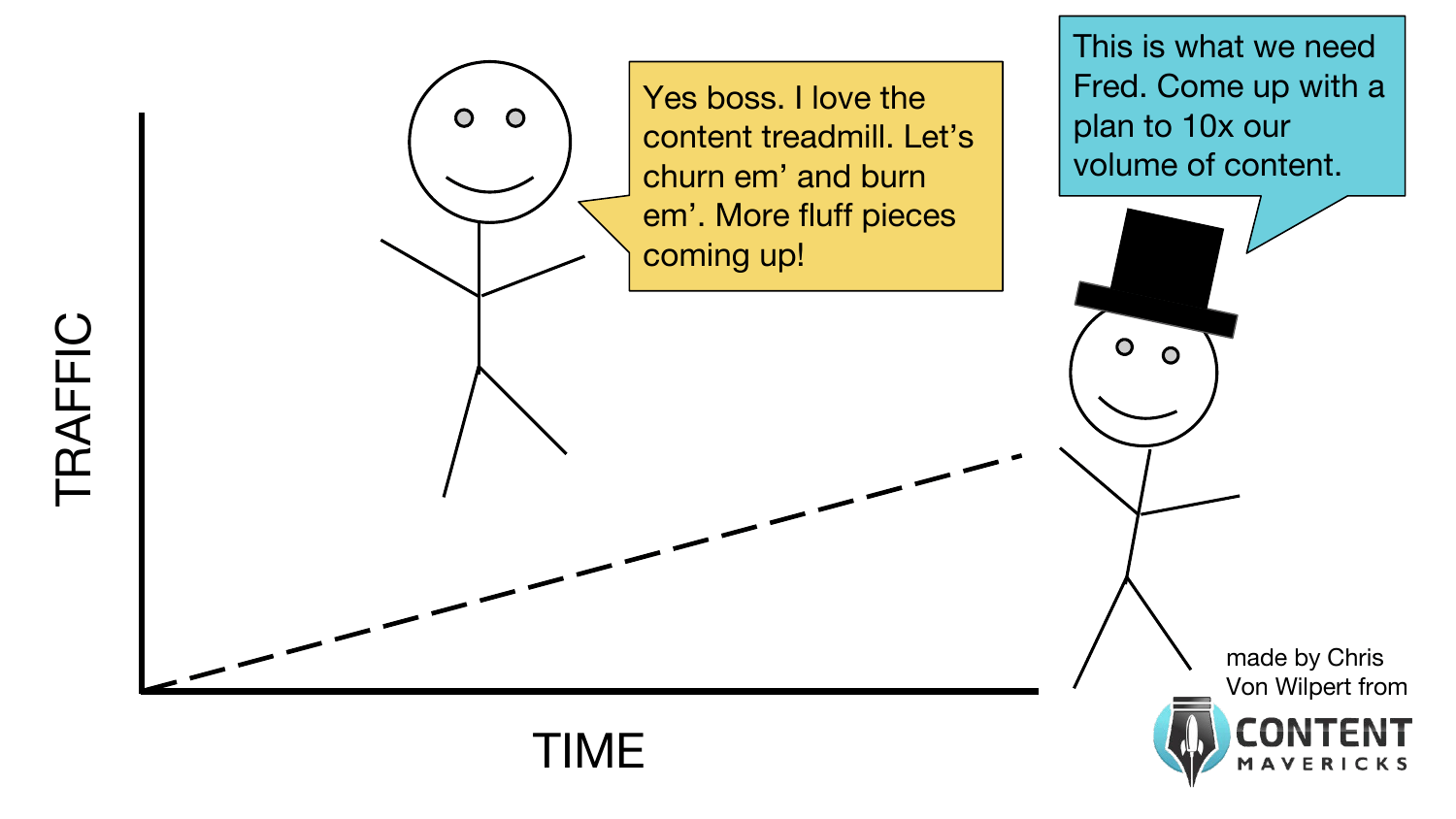
This is why most companies never reach a tipping point of exponential traffic growth.
Don’t be like Freddie. Highlight the text below and hit the Twitter icon to tweet a link to this article and tag your boss (or any other people who think more content = more traffic.)
More content ≠ More traffic. This content distribution strategy by @vonwilpert proves it:
If churning out more content isn’t the answer to getting more traffic and true fans, then what is?
Using my True Fan Multiplier Method:

There is no “true fan hack.”
You need to earn people’s trust.
Do whatever you can to get personal, solve their pains, and grant their wishes.
When I had no true fans in my inner circle, this is what I did:
- Made a list of my Dream 100.
- Wrote one piece of content that could help them.
- Sent it to them via email.
This is the piece of content I wrote and distributed:

This wasn’t any ordinary piece of content.
It was remarkable, targeted at my market.
I call this type of content “Greatest Hits Content.”
After reading it, HubSpot’s CMO contacted me to talk, and Noah Kagan at Sumo later reached out to work together.
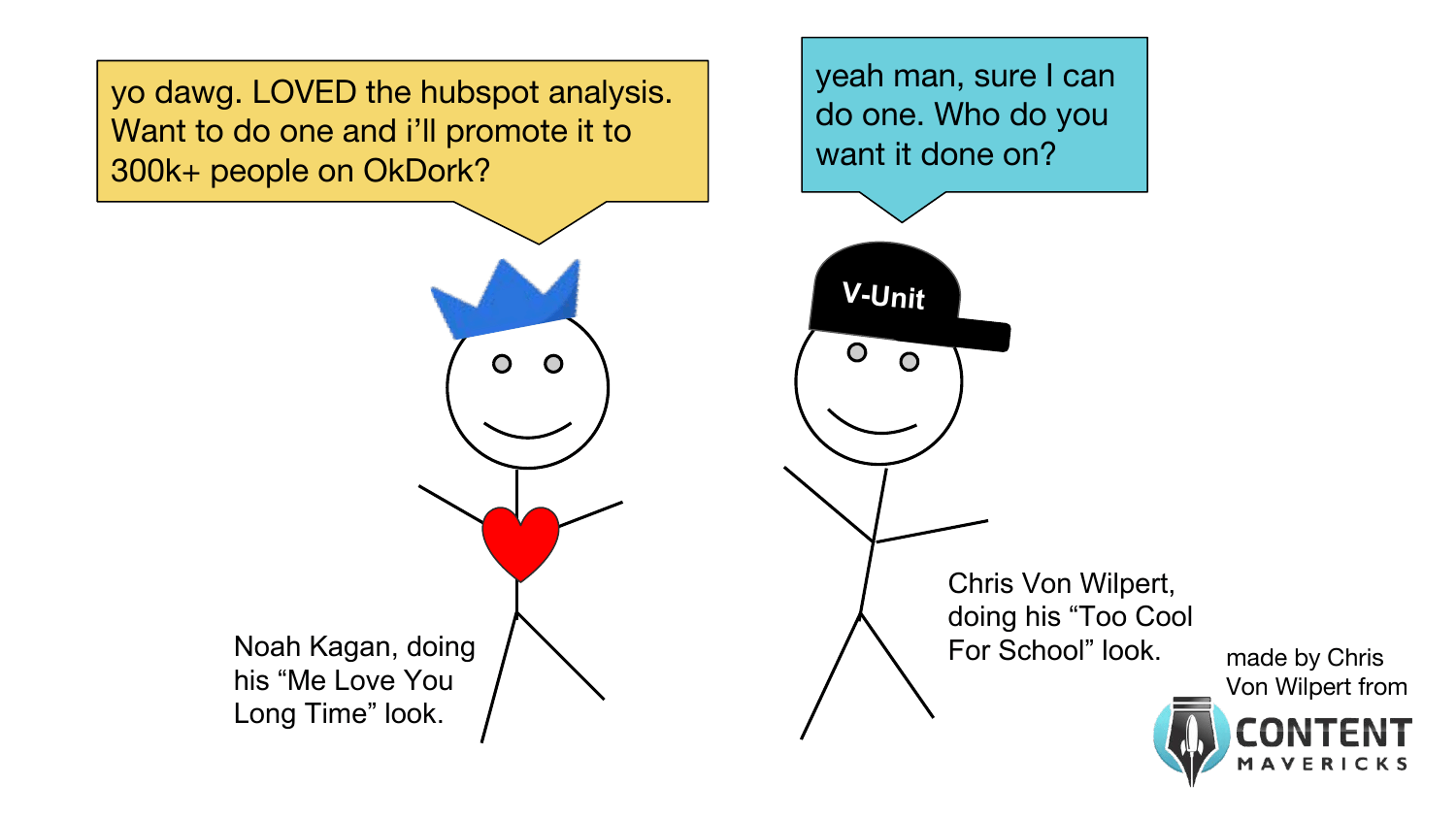
I documented what I did to distribute this piece of Greatest Hits content (and recorded a video) of how I got my first 1,000 true fans on the link below so you can see.
=> Click here to get the full Greatest Hits content case study.
Now it’s time to talk about how to grow your social circle.
Social Circle
Your social circle are fans that follow you on social media. Some are your true fans, but most haven’t reached “true fan” status yet. They will:
- Like your status updates.
- Comment on your posts.
- Share your posts (occasionally).
To grow your social circle you need to give consistent value to your social network.
This isn’t about being on EVERY social media platform.
That’s how you spread yourself too thin.
To succeed at growing your social circle, look at where people in your market hang out the most, and focus growing your fan base on that ONE platform.
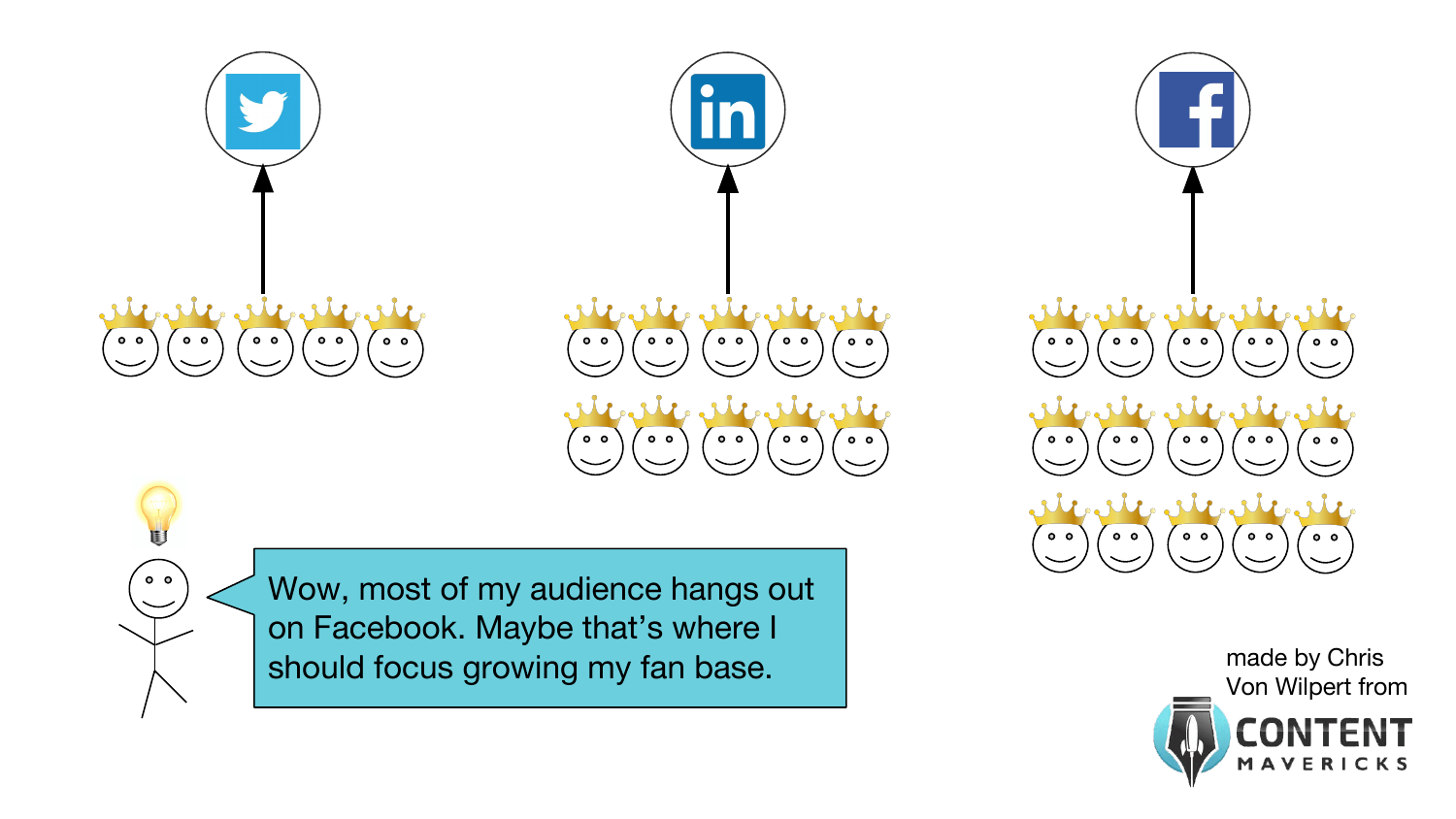
An easy way to find your ONE platform is to look at other influencers and company’s social profiles in your market. Then see which of their social media posts get the most engagement.
I call this platform your “social media supernode.”
It’s a supernode because when the people in your social circle (aka the nodes) engage with your posts, they spread it to new people who never knew about you before.

When no one in my market was inside my social circle, I provided value once a week inside one Facebook group to grow it.
Here’s one example where I gave free marketing tips in the group:

Here’s another example where I offer to help connect software founders with venture capital investors:

Here’s another where I offer free consulting advice:

Once I had a small following, I shared stories my audience would love. For example, the post embedded below got over 100 comments in the first 18 hours.
This activated my social media supernode so more and more people started following me organically, and my content got more reach.
You can do the same thing on your company profile.
Instead of queuing up your social media planner with blog post links, start posting timely, relevant status updates that are a mix of different content.
Here are some best practices you can follow (and adapt to match your own style):
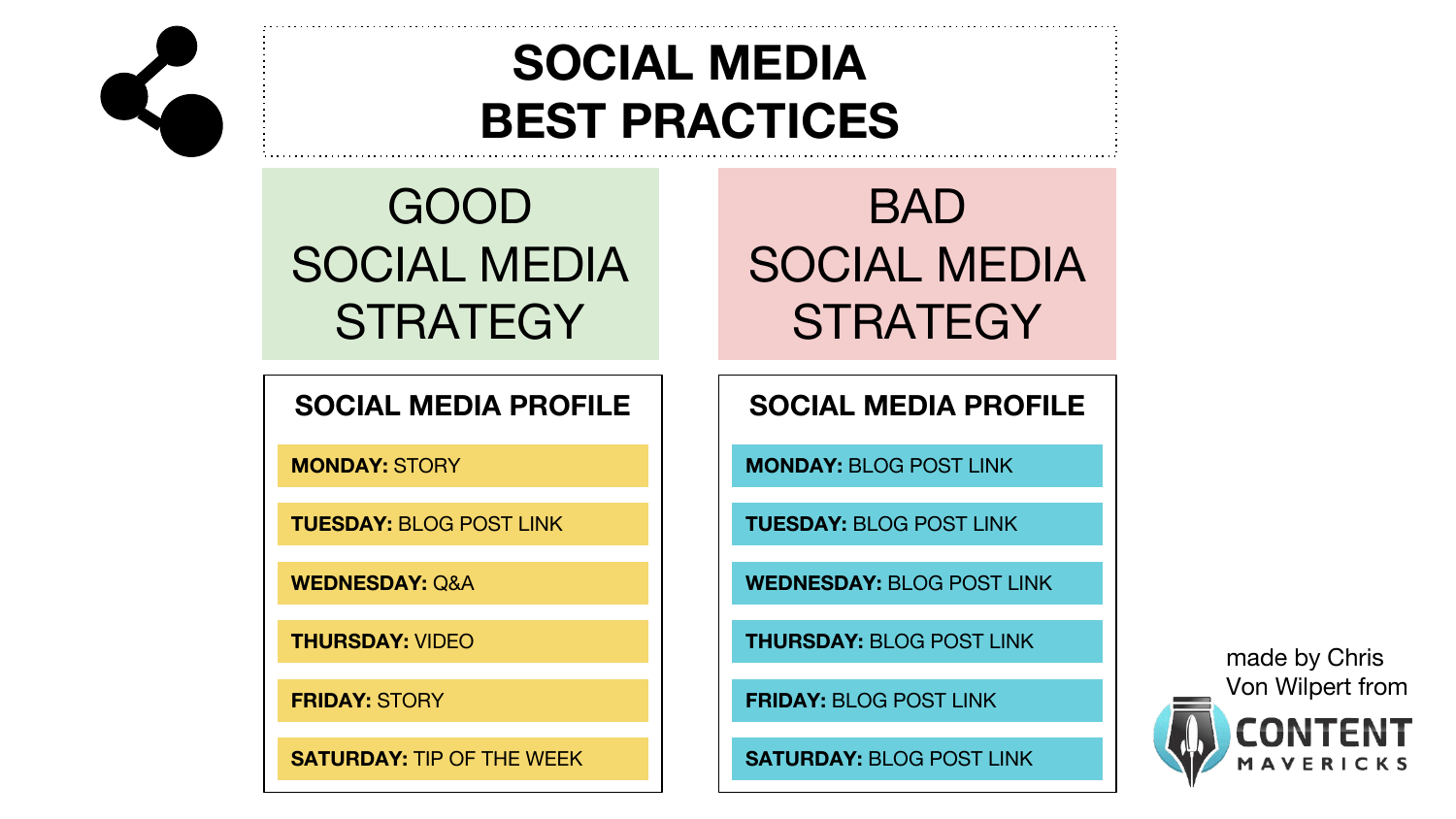
To recap, here’s what you need to do to grow your social circle:
- If you have 0 fans, pick one social group where your market hang out, answer questions and write helpful posts (do not spam your links).
- Post timely, relevant status updates that are a mix of different content on your own social profile (or your company’s) using a schedule that works for you (daily, once a week, bi-weekly, etc).
Growing your social circle takes dedication and time, but it’s worth it.
If you’re growing a company profile, write your posts like you would to friends, and sign-off with your own name. People will better connect with your brand, like this:

The bigger your social network becomes, the more nodes you will have to amplify your content reach (and the more real relationships you will develop with your fans.)
Now let’s move onto how to grow your outer circle.
Outer Circle
Your outer circle are people who have no idea who you are. They’re in your target market, but have never seen or read your content before. These people:
- Follow influencers in your market.
- Hang out inside different tribes online.
- Read blogs, listen to podcasts, and watch YouTube videos.
To move people from your outer circle into your social circle and inner circle, you need to build a strong relationship with the people who influence your outer circle.
I call these people the “big dawgs.”
Big dawgs have spent years growing an audience of true fans.
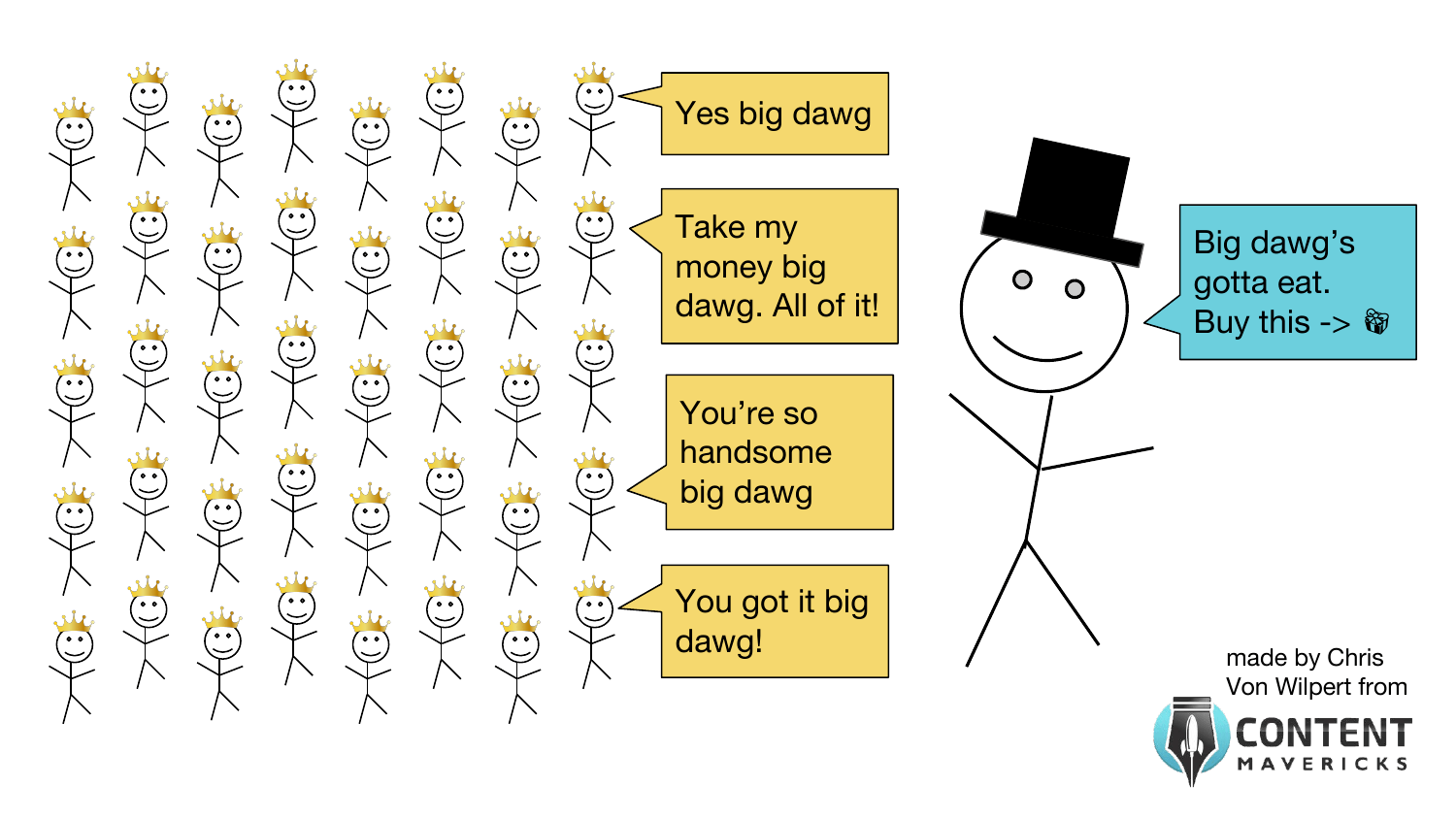
There are three things you need to know about big dawgs:
- They’re hard to reach.
- They often have aggressive goals they’re trying to hit.
- They can multiply your fan base with one email send or one social post.
To get on a big dawg’s radar you need to find out what their goal is right now, then help them, without any expectation of getting something in return.
The best way to reach the biggest of big dawgs is to use The Big Dawg Level-Up Technique.
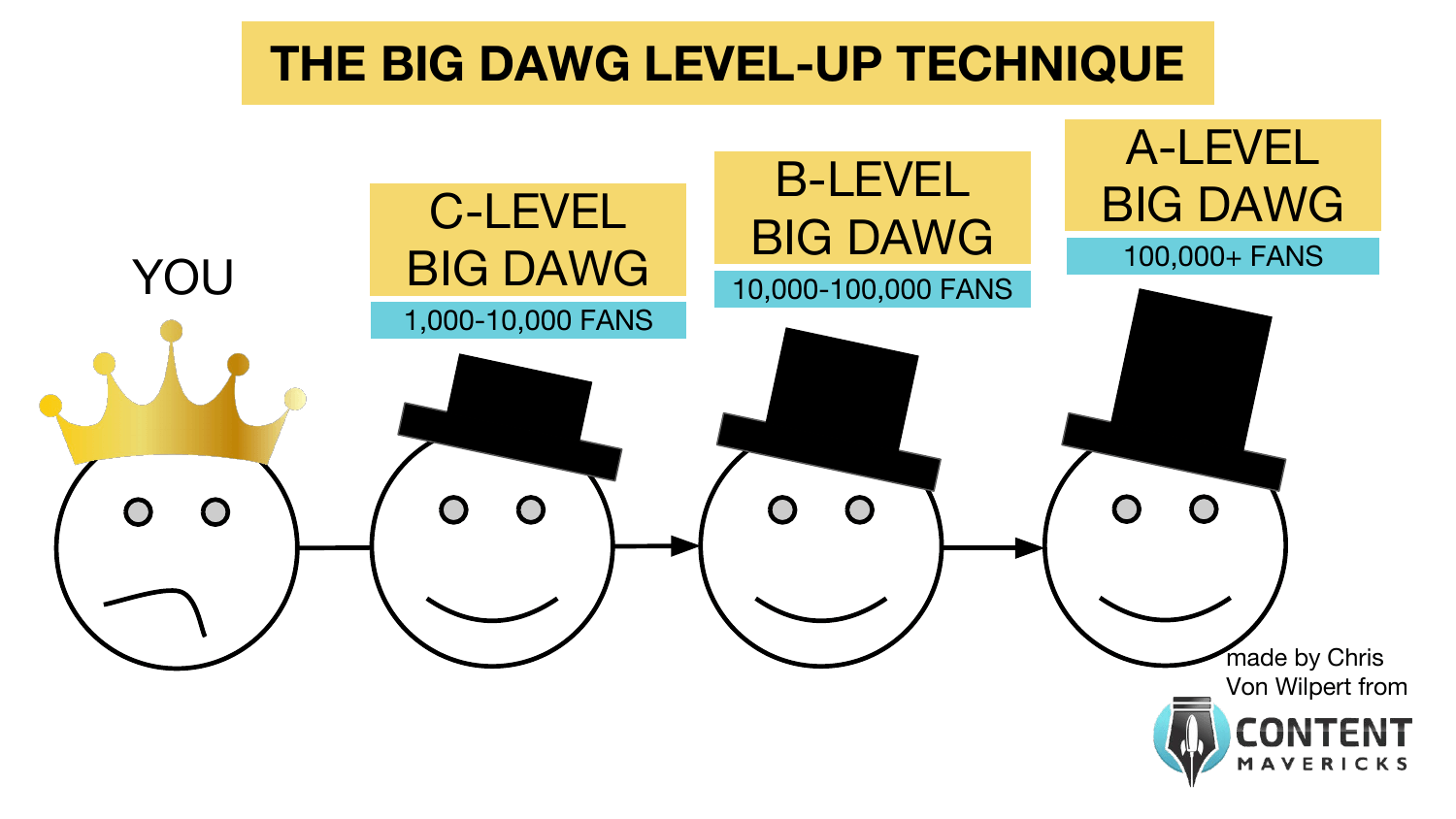
Start by helping a C-Level Big Dawg that has a small engaged audience in the 1,000 to 10,000 fan range, then level-up.
Here’s how:
- Research your target big dawgs social posts, blog posts, videos, etc to find what goal is most important for them to hit right now.
- Send them something that will help them hit their goal.
- Make it their most successful project ever.
When Noah Kagan (9-figure founder of Sumo.com) first reached out to me, I studied all his content, and found that he mentioned this in one of his blog posts:

Once I knew that, when it came to doing a guest post for Noah, I sent him this message on the items I’d do to distribute it:

This lead to us working together on a much bigger project at Sumo where we get to have fun building a worldwide known brand.
Want my blueprint to get your first 1,000 true fans, and more?
Download my Content Distribution Checklist with the inner circle, social circle, and outer circle action items I use. Inside you’ll get links to examples for every action item.
Now you know how to grow your inner, social, and outer circles, it’s time to start using free traffic multipliers to distribute your content.
Step 2: Use Free Traffic Multipliers To Get Thousands Of Free Clicks From Fans Hungry For Content On Your Topic
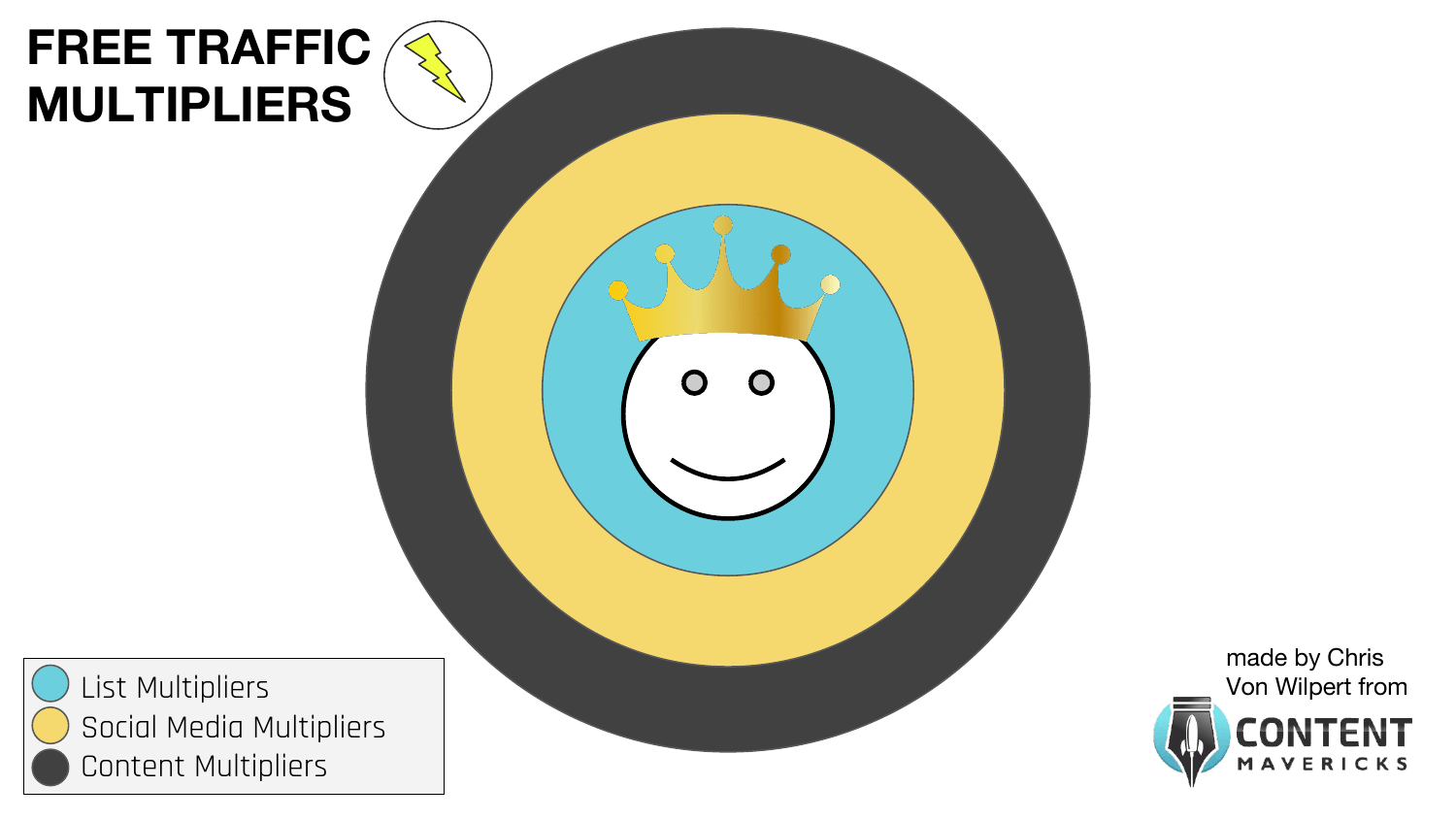
List Multipliers
List multipliers are the distribution lists you use to distribute your content. They include your:
- Email list
- Push notification list
- Facebook messenger list
- Outreach list
Below I’m going to show you the top example of how I build each of these lists, and best practices to distribute your content to each of them.
Email List
My #1 method for growing an email list is using ConvertBox content upgrades, like this:
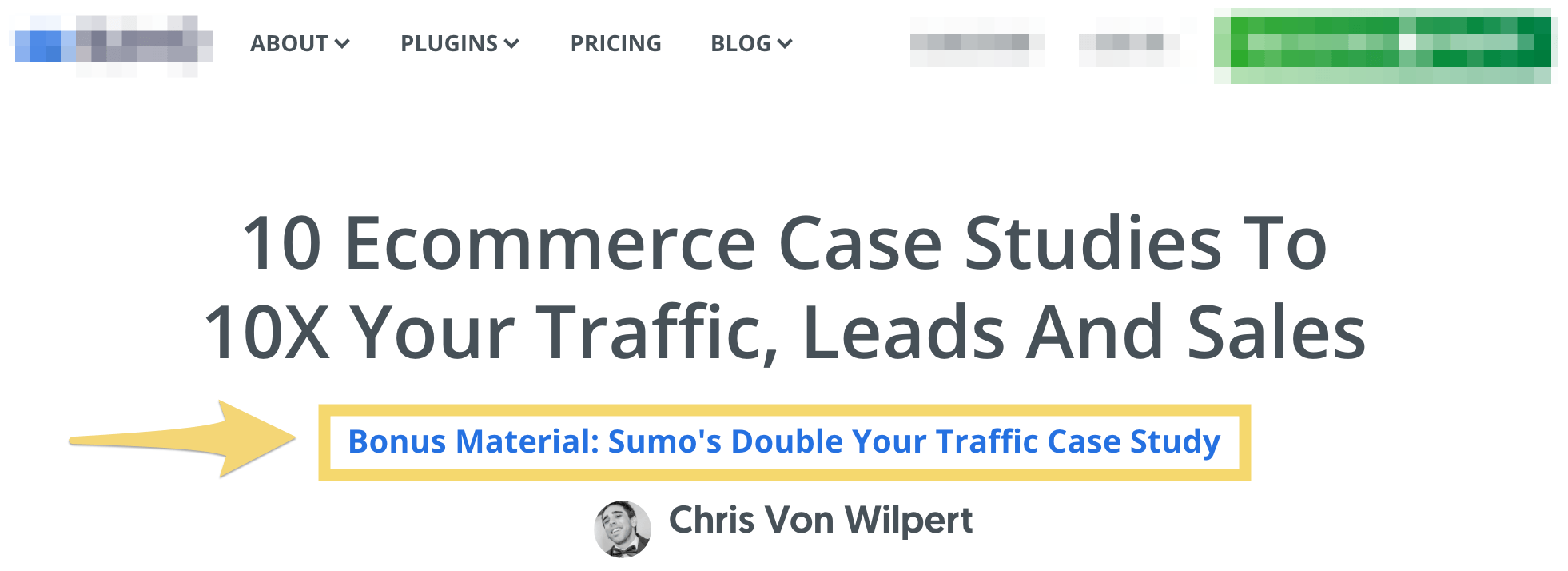
Best practices for a high-converting content upgrade are:
- You give people more of what they came for in the first place (in the above example the content is about 10 ecommerce case studies, and my upgrade is a bonus case study.)
- You offer the upgrade at the top of your content (based on heat map data I’ve found this is where I get the most clicks.)
- You offer the upgrade inside the body of your content within context (below is an example of where I provide a contextually relevant call to action for my upgrade towards the end of the content.)

Think of a good content upgrade like a sandwich. Without the bun on the top AND bottom (i.e. your content upgrade), you’ve got nothing holding your content together to convert your readers into subscribers.

Whenever I release a new piece of content I then send an email, like this:

Best practices for a high click-through rate email are:
- You link to ONE piece of content in the email.
- You tell an interesting story about the content people can relate to.
- You make sure you’re not linking to any images in the email (so Google doesn’t detect your email as a promotional newsletter, and send your email to the Promotions tab vs the Primary tab in Gmail.)

Push Notification List
My #1 method for growing a push notification list is using a lead magnet on my main blog page. People can join the push notification list by clicking on a small tab that sits on the bottom right of the main blog page.
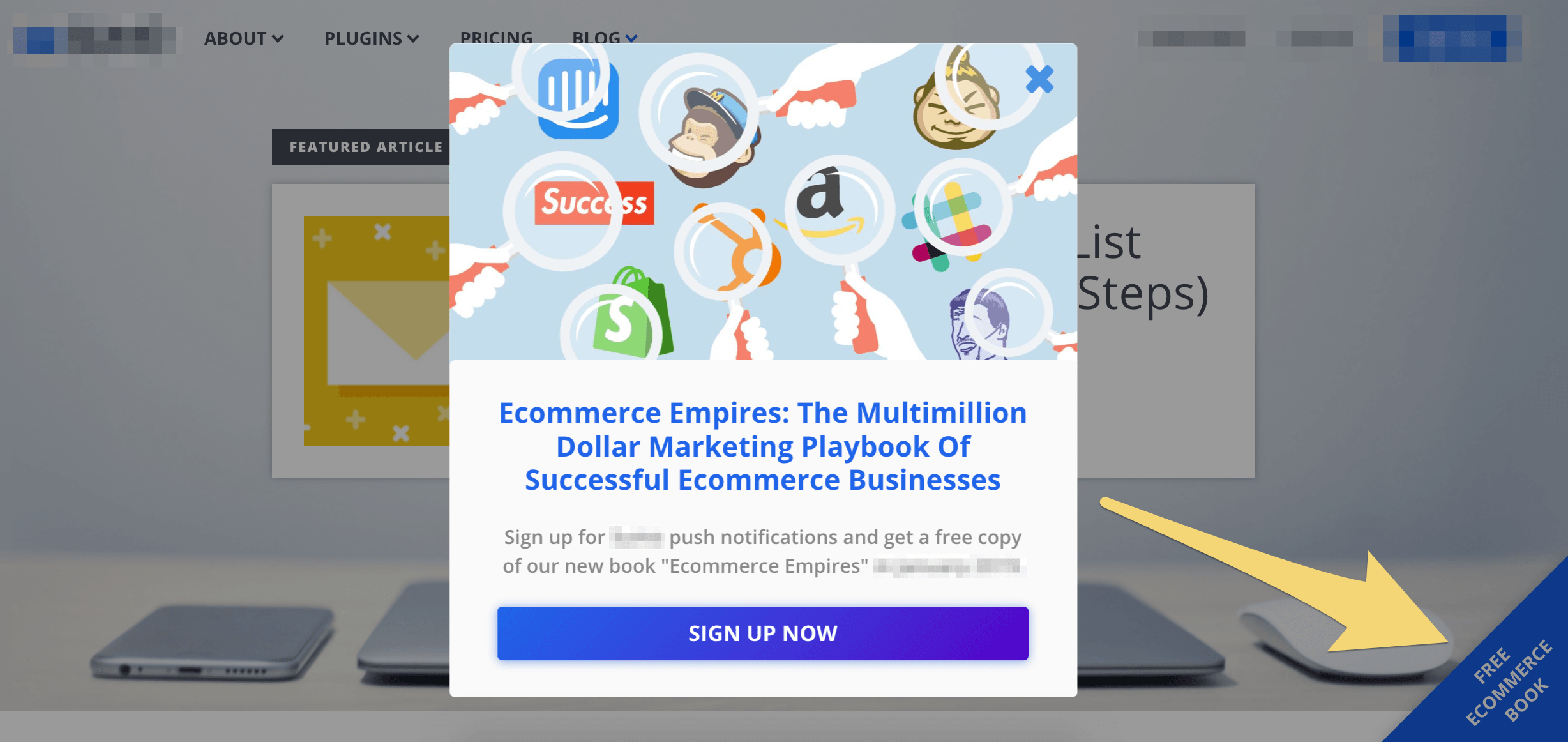
Best practices for a high-converting lead magnet are:
- You offer something highly relevant to the traffic visiting your website (in the above example the lead magnet is an Ecommerce Book of successful ecommerce businesses, because I’m driving traffic from mostly ecommerce store owners.)
- You use a curiosity gap to incentivise people to want to access it (my curiosity gap is to see “the multimillion dollar marketing playbook of successful ecommerce businesses” in the book.)
- You time it to “popup” so new visitors see it (I use ConvertBox to make mine “popup” after 5 seconds on the blog page only.)
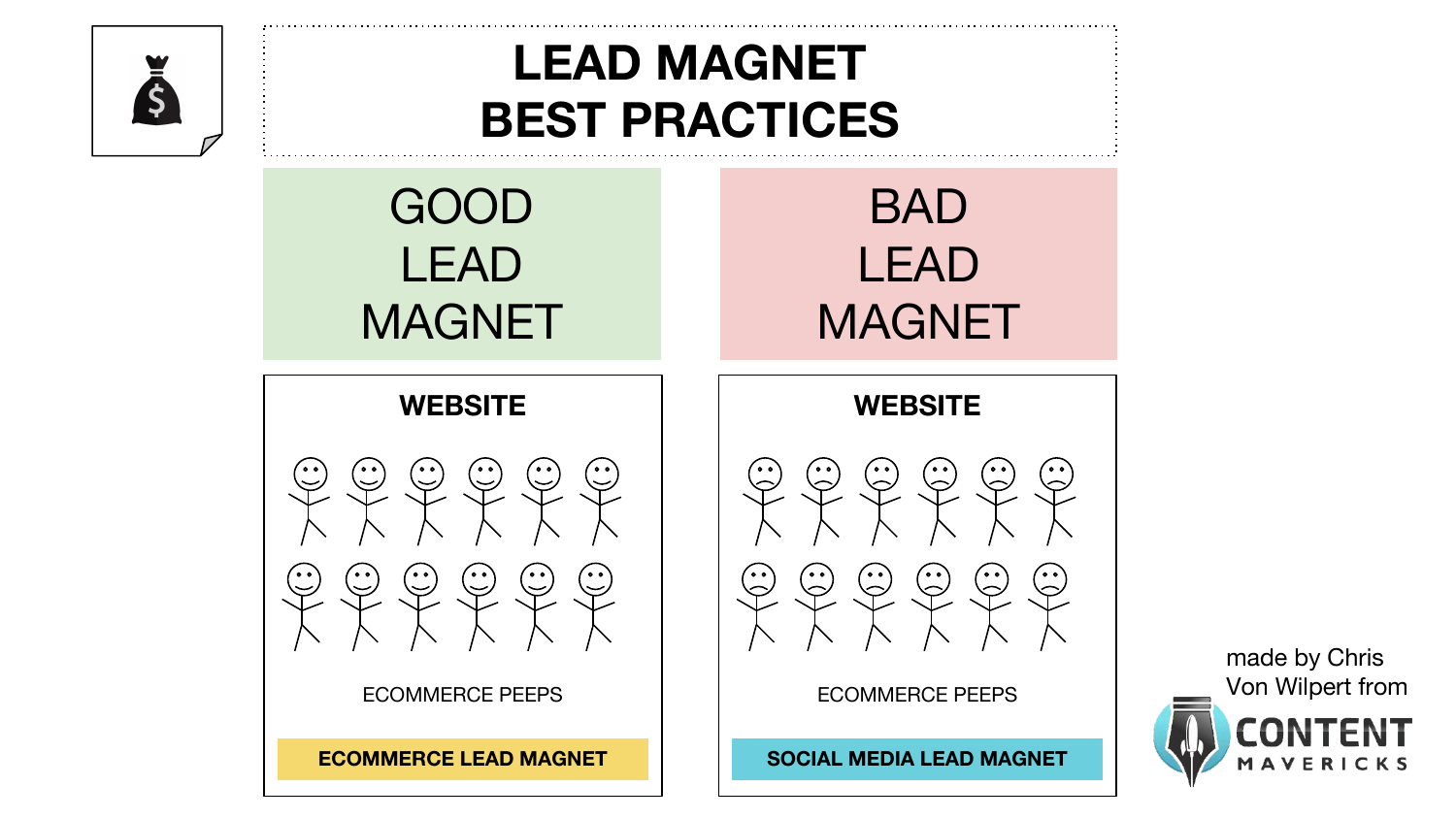
Whenever I release a new piece of content I send a push notification, like this:

Best practices for a high click-through rate push notification are:
- You link to ONE piece of content in the push notification.
- You use a 30 character headline for the content (if you use >30 characters, your headline will get cut-off like below.)

3. You use a 30 character description (so your description text doesn’t get cut-off).
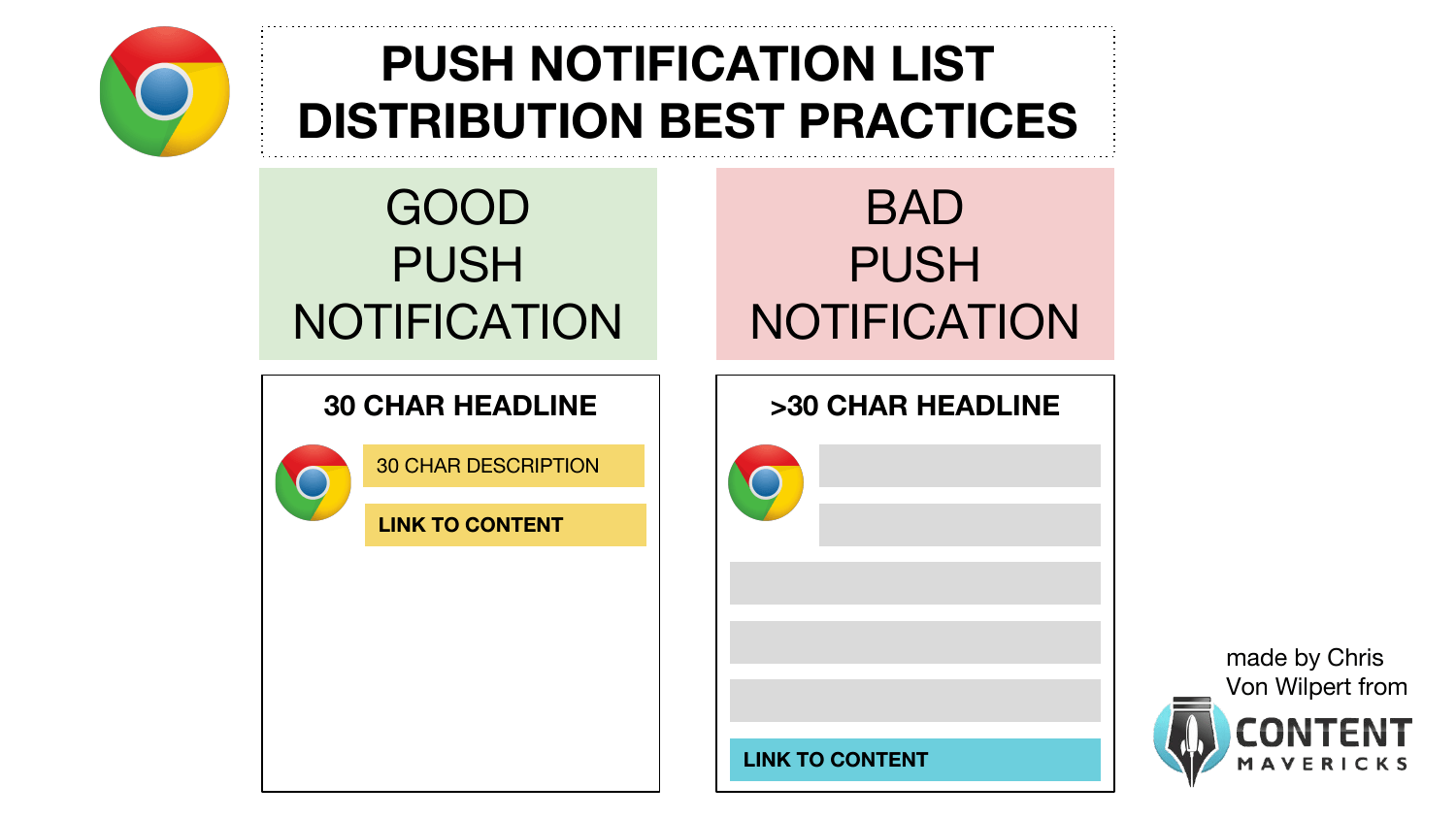
Facebook Messenger List
My #1 method for growing a Facebook Messenger list is using an offer for content series updates on my blog posts. I set the offer to show inside a ConvertBox Callout Modal after someone has scrolled 10%, and if the referrer domain is Facebook.com:

Best practices for a high-converting content series are:
- You research the most shared topics in your market.
- You research your customers jobs-to-be-done.
- You combine both to come up with your own unique content series.
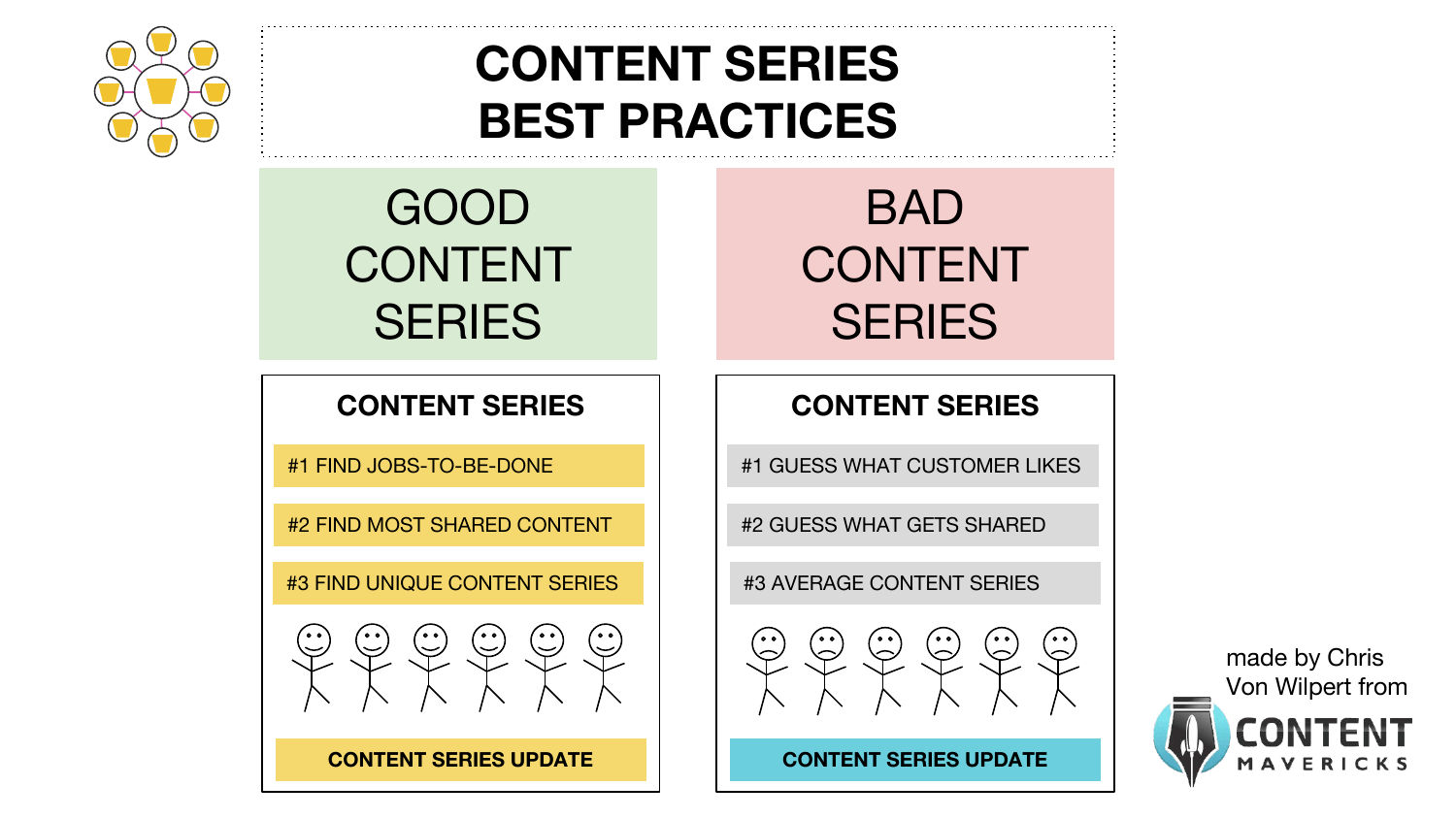
I offer content series updates, because “blog post updates” aren’t an attractive offer, and I know from Google Analytics traffic data that my growth studies are some of my most popular content.
Whenever I release a new piece of content I send a Facebook messenger notification, like this:

Best practices for a high click-through rate Facebook Messenger notification are:
- You address the person by their first name, use an image, and short teaser.
- You ask people if they want a link to the content first.
- You provide a link and button to click-through to your content.

Outreach List
My #1 method for building my outreach list is to research people who’ve written about, shared or shown interest in the topic related to my piece of content.
To find these people, I search:
- Google for people who’ve written top posts on the topic.
- YouTube for people who’ve produced top videos on the topic.
- Twitter for people who’ve shared similar content on the topic.
- Community groups for people who’ve shared similar content on the topic.

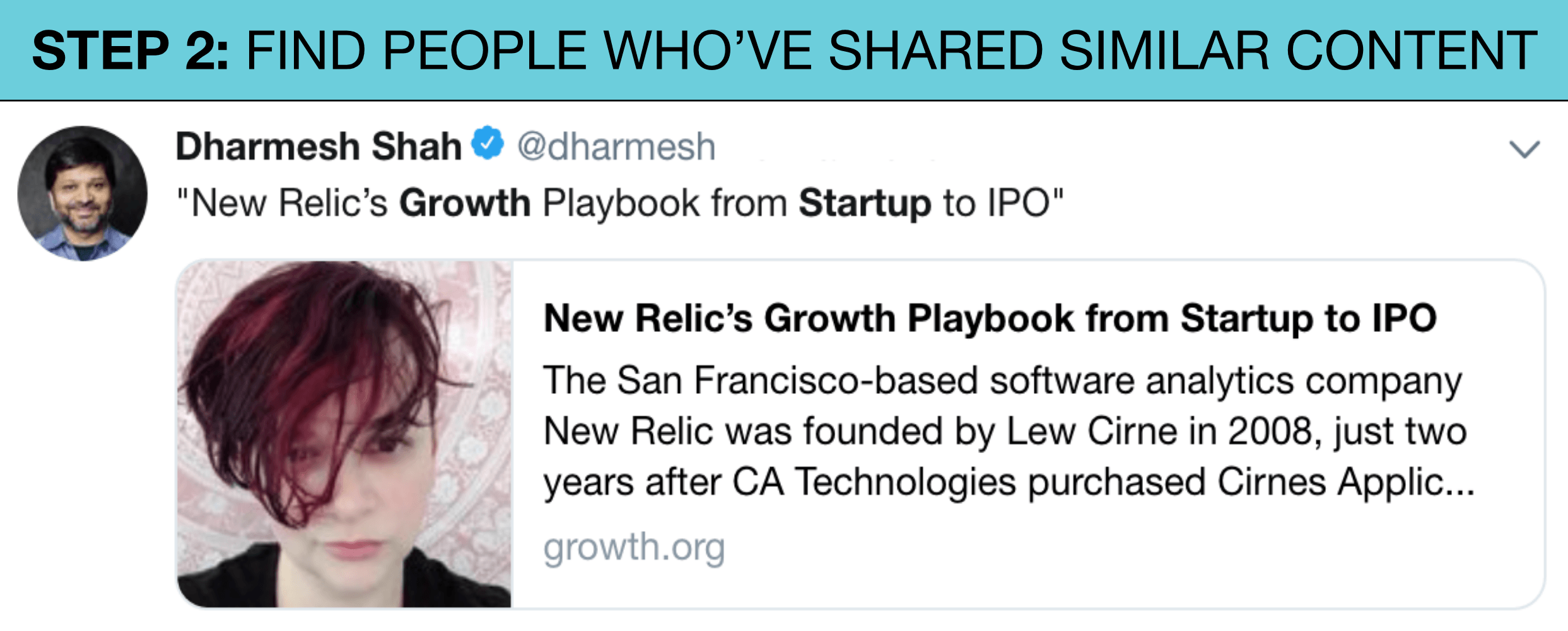
Best practices for a high-converting outreach list are:
- You find people who are interested in the topic of your content (produced content on a similar topic, or shared content on a similar topic.)
- You like, share or comment on something of theirs you genuinely like (so you’re not a complete stranger when it comes to sending your outreach.)
- You only add them to your list if you think they’ll love your perspective (people don’t like seeing a rip-off of their own or someone else’s content.)
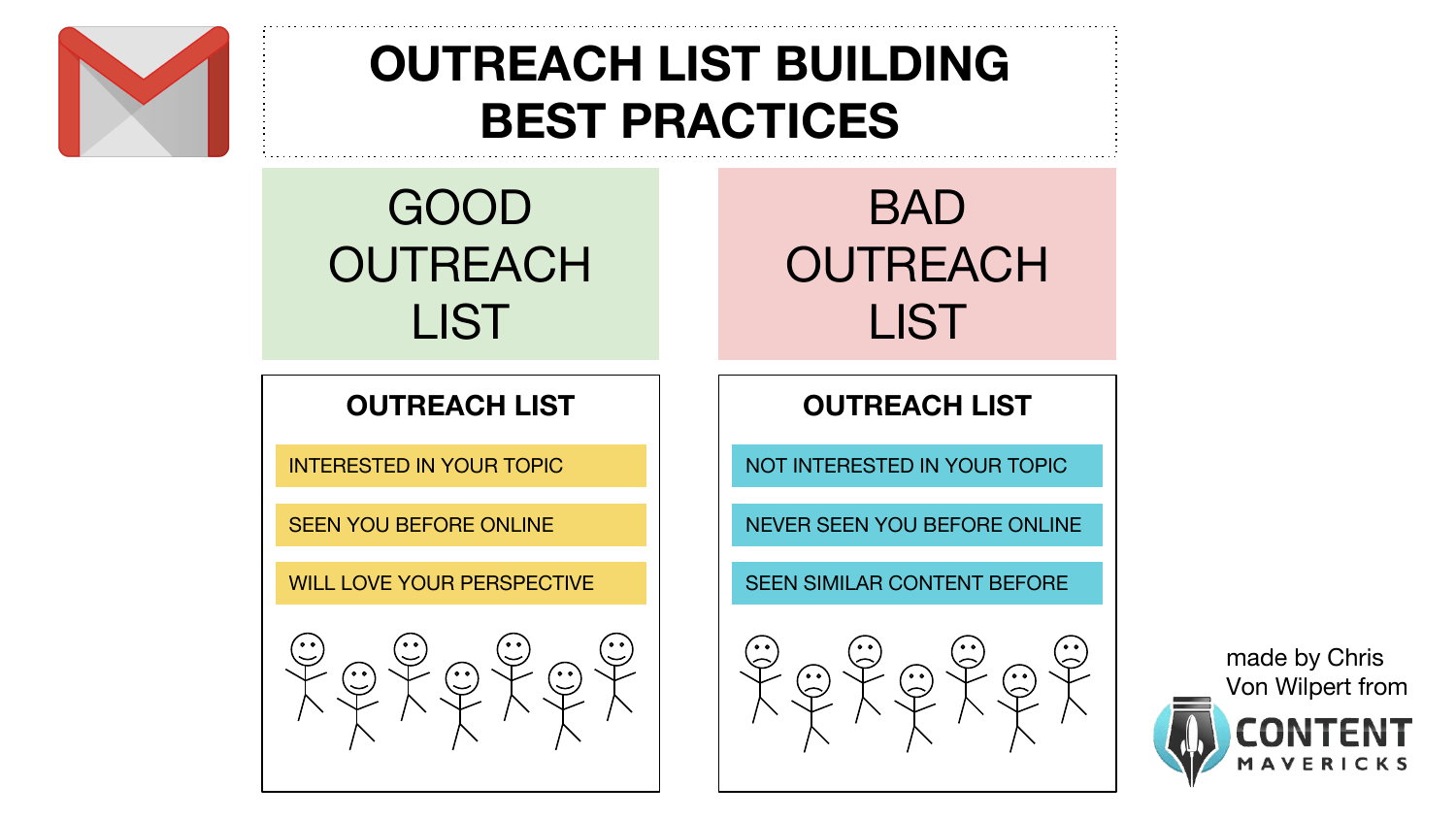
Whenever I release a new piece of content I send an outreach email, like this:
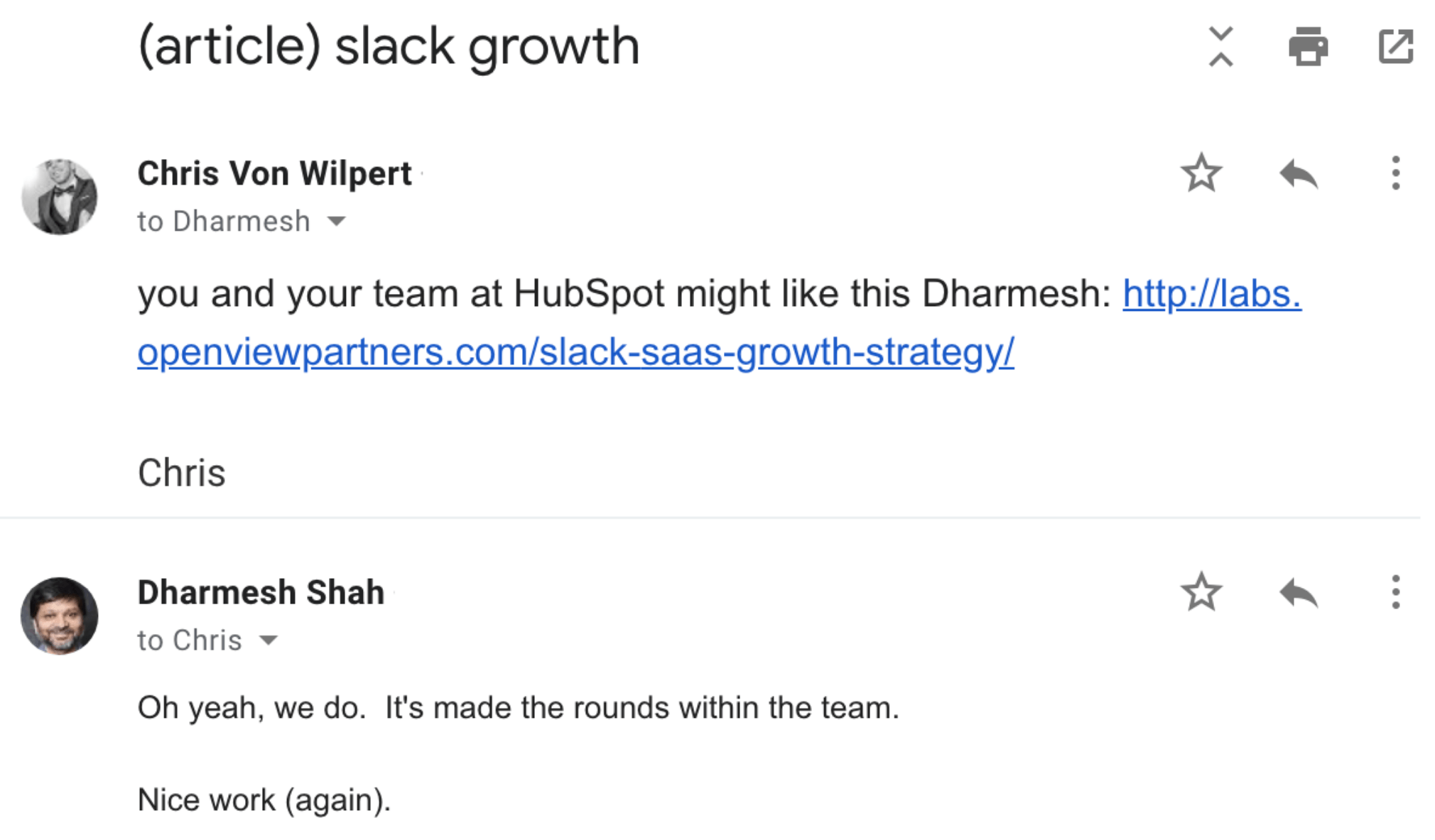
Best practices for a high-converting email outreach are:
- You link to ONE piece of content in the outreach email.
- You use a simple subject line that matches the content you’re sending.
- You keep your outreach to two sentences maximum.
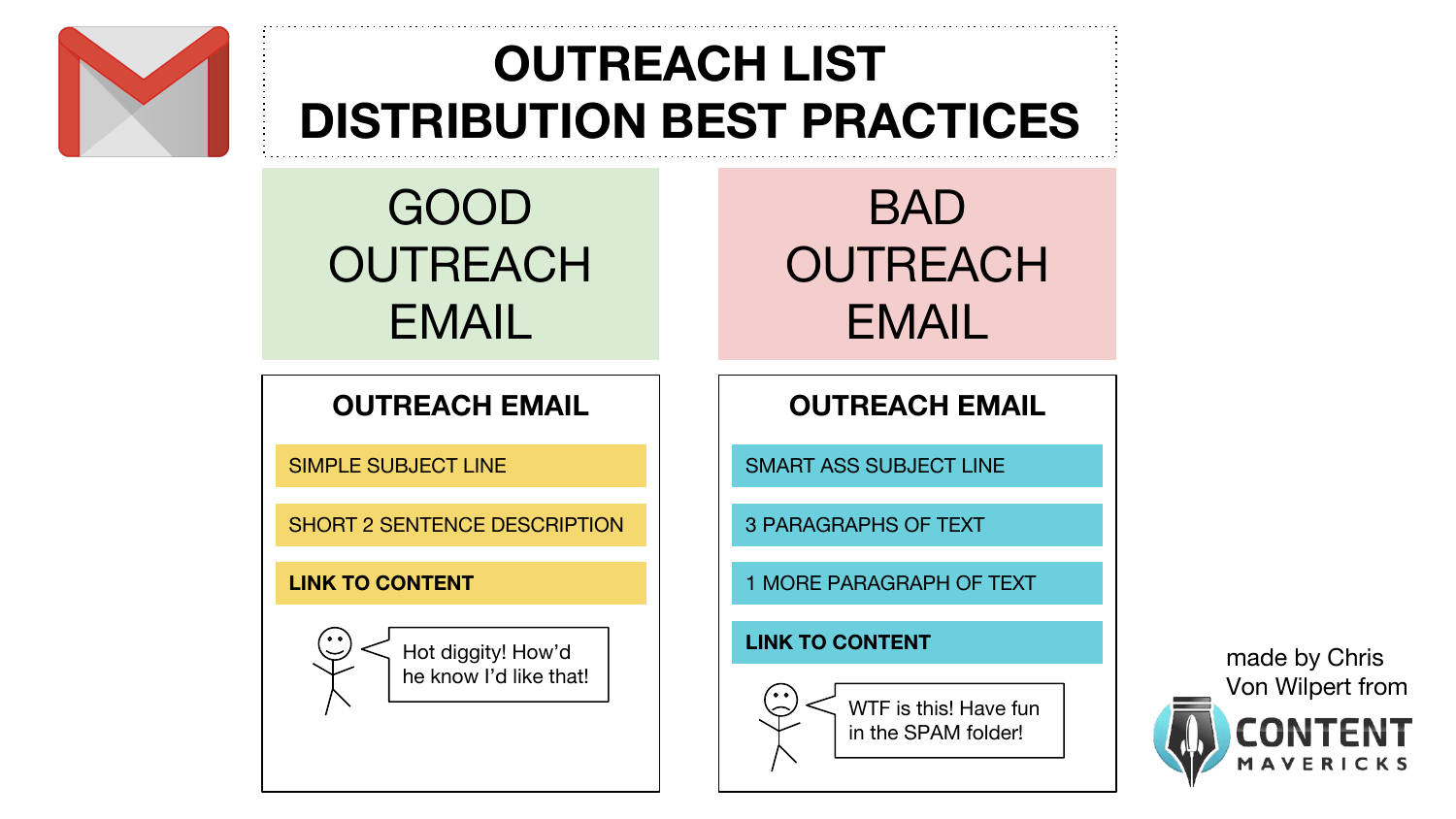
You’ll be surprised how many people share and link to your content when you do outreach like you’re sending a useful piece of content to a friend.
Now, let’s talk about the next free traffic multiplier you can use to distribute your content: social media multipliers.
Social Media Multipliers
Social media multipliers are the social media platforms you use to distribute your content. There are lots of platforms you can post on, personally I like to focus on what I call “The Big 3”:
Below I’m going to show you my #1 method for getting max reach for content on The Big 3.
My #1 method for amplifying content on Facebook is using a social multiplier magnet to incentivize fans to comment/share, like this:

Best practices for a high reach Facebook post are:
- You use at least one piece of social proof to give people a reason to click (in the example above I name drop Noah’s name because I know people in my market know who Noah Kagan is.)
- You offer a social multiplier magnet for people who comment/share (in the example above I offer a pdf of the tools I used to reverse engineer the company I wrote about.)
- You use an image with high click-through rate elements (diagonal lines, recognizable objects, and high contrast color.)
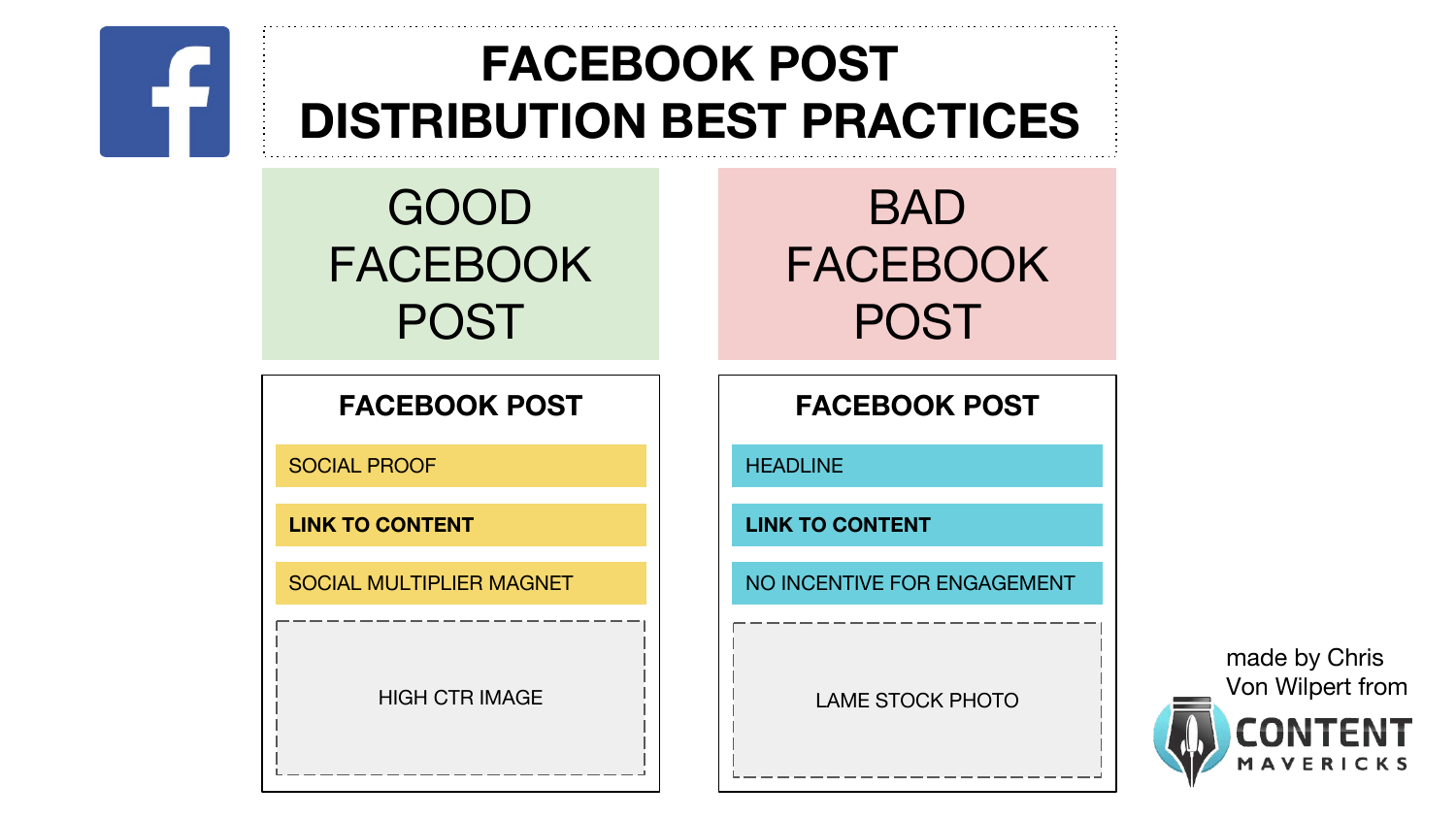
My #1 method for amplifying content on Twitter is using a tweetstorm to tell the story behind my content, like this:
1/ I used to make over $10k a month…
With a one-man ad agency and a handful of contractors.
I started helping a software company in Australia managing their Google ads.
They paid me $3,250 a month to start. (I charged $1k + 15% of their $15,000/mo ad spend) –>
— Chris Von Wilpert (@vonwilpert) November 6, 2018
Best practices for a high reach Twitter post are:
- You tell a story people want to retweet to their fans (in the example above I use a 14-part tweetstorm to tell the story of how I used to make over $10k per month.)
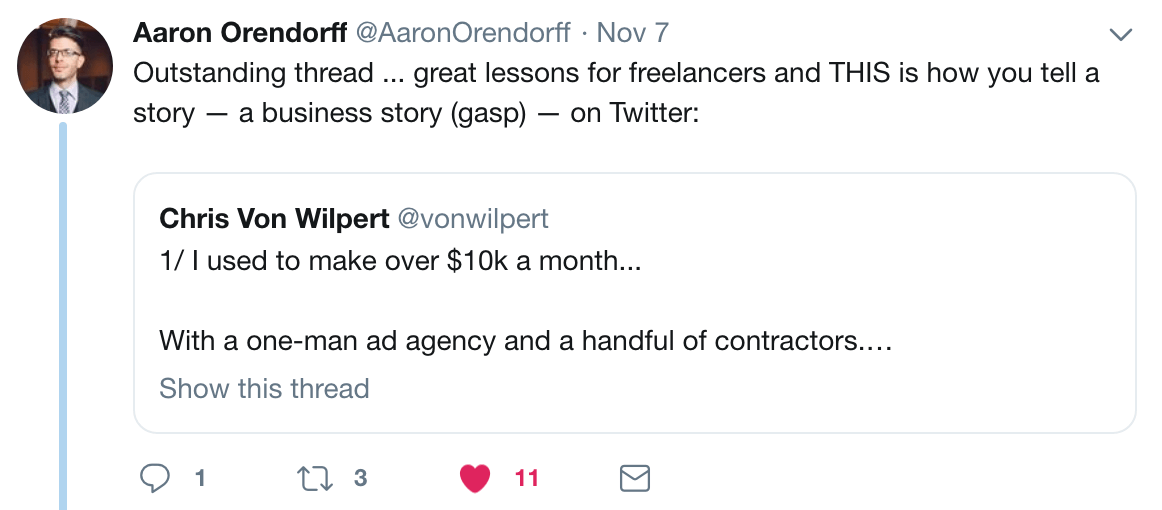
2. You give people the gritty, bloody, exquisite detail of your story (in the example above I add drama by highlighting the hero’s journey from making $10k, to losing it all, then making even more so people are pumped to “win”.)

3. You link to your content in the last tweet of your tweetstorm (in the example above I link to the strategy I used to make $100,000 from one blog post with $688.71 ad spend.)
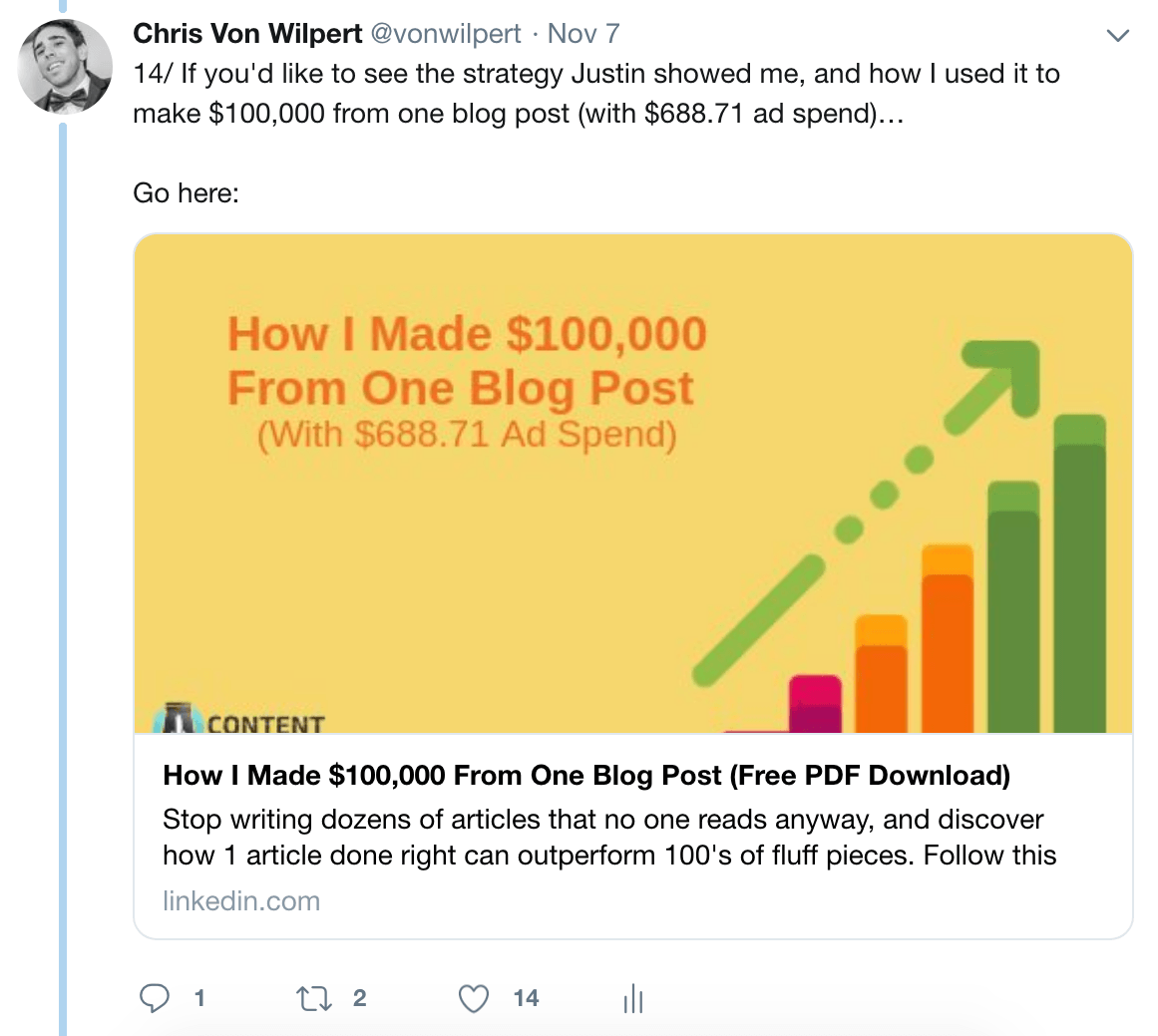
Here’s a simple illustration of what a good and bad Twitter post looks like:
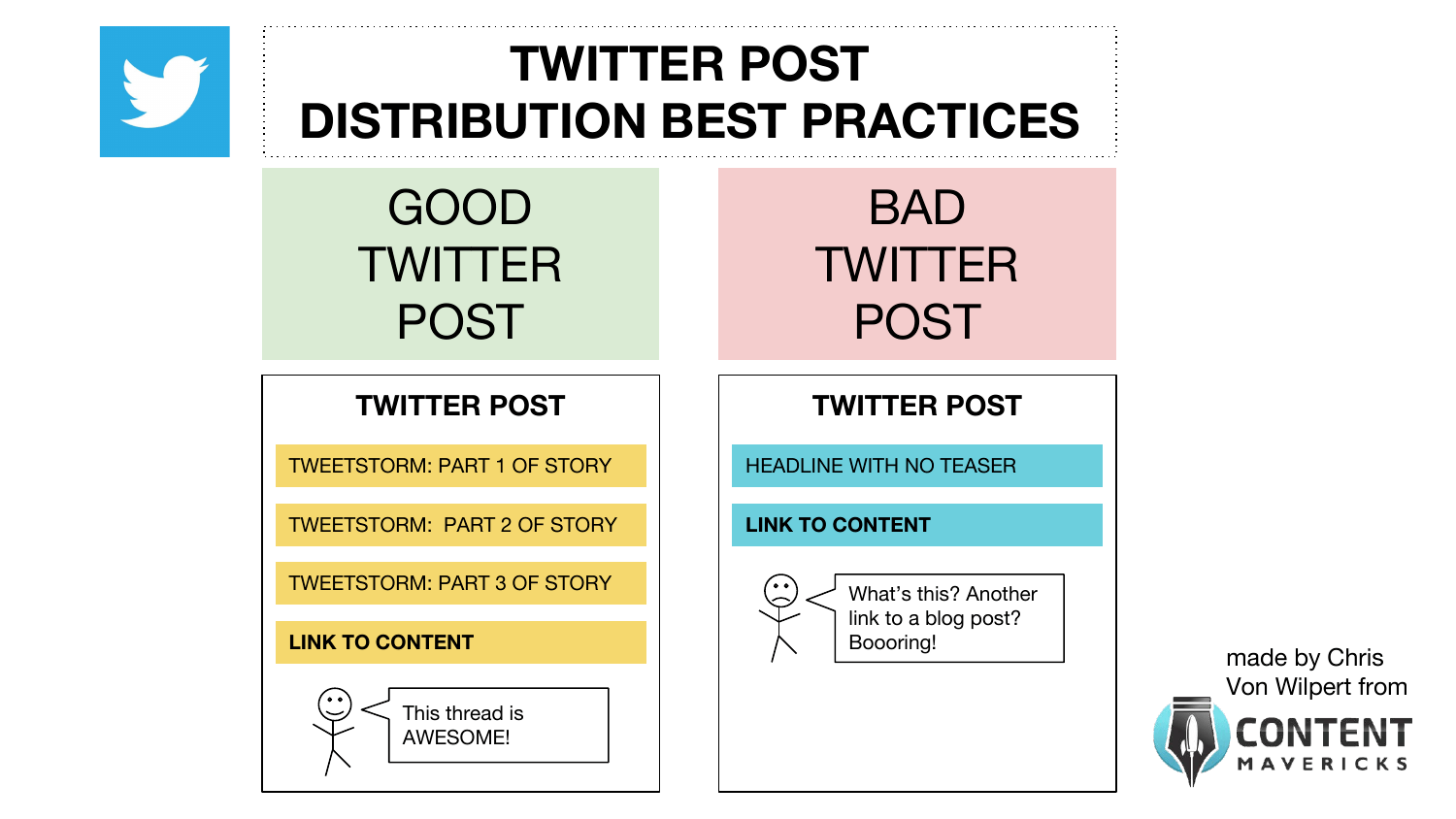
My #1 method for amplifying content on LinkedIn is using a teaser post, like this:
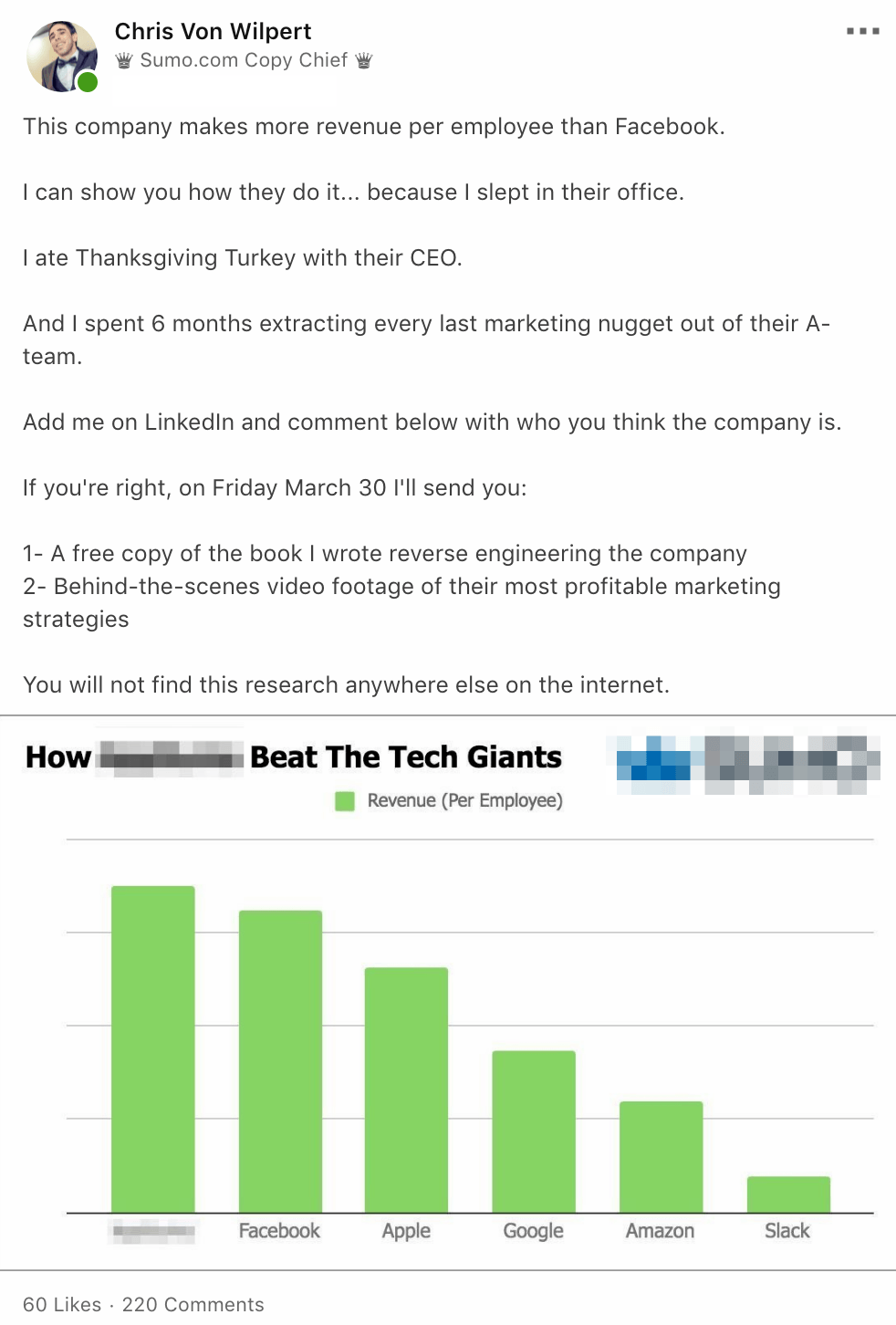
This video shows EXACTLY what I did to get 220 comments and build up an audience of people eager to read my content:
Why should you care about getting comments?
More comments means more engagement signal.
More engagement signal means more reach, and more reach means NEW BLOOD!
Best practices for a high reach LinkedIn post are:
- You attach something your market already knows and loves to the content you are promoting (in the example above I say “this company makes more revenue per employee than Facebook” because I know my market loves Facebook and revenue growth.)
- You require people to leave a comment answering a question related to the topic of your content (in the example above I ask people to guess who they think the company is I’m talking about.)
- You include a teaser image from your post to arouse people’s curiosity (in the example above I include a revenue per employee bar graph of six well-known companies, and blur out the top one.)
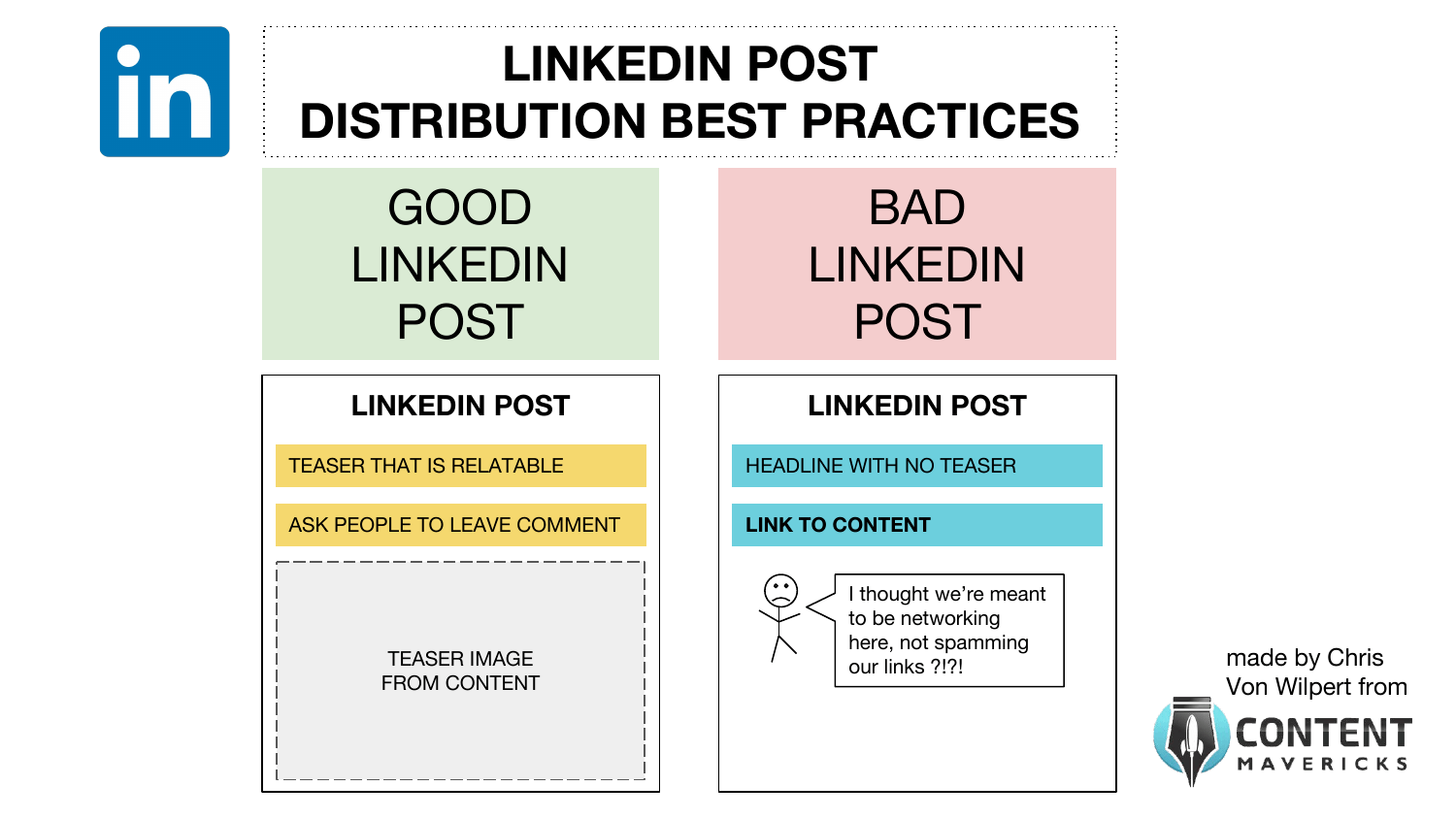
Once your content launches, you should message everyone with a link to your content, like this:

Now we’ve covered The Big 3 social media multipliers, let’s talk about the last free traffic multiplier you can use to distribute your content: content multipliers.
Content Multipliers
Content multipliers are taking your Greatest Hits content and creating variations of it that match the context of different platforms. This is where you optimize your content for a:
- LinkedIn Article
- YouTube Video
- Facebook Video
- Medium Story
- Quora Answer
- iTunes Podcast
To do it successfully, you should use The Content Multiplier Pyramid.
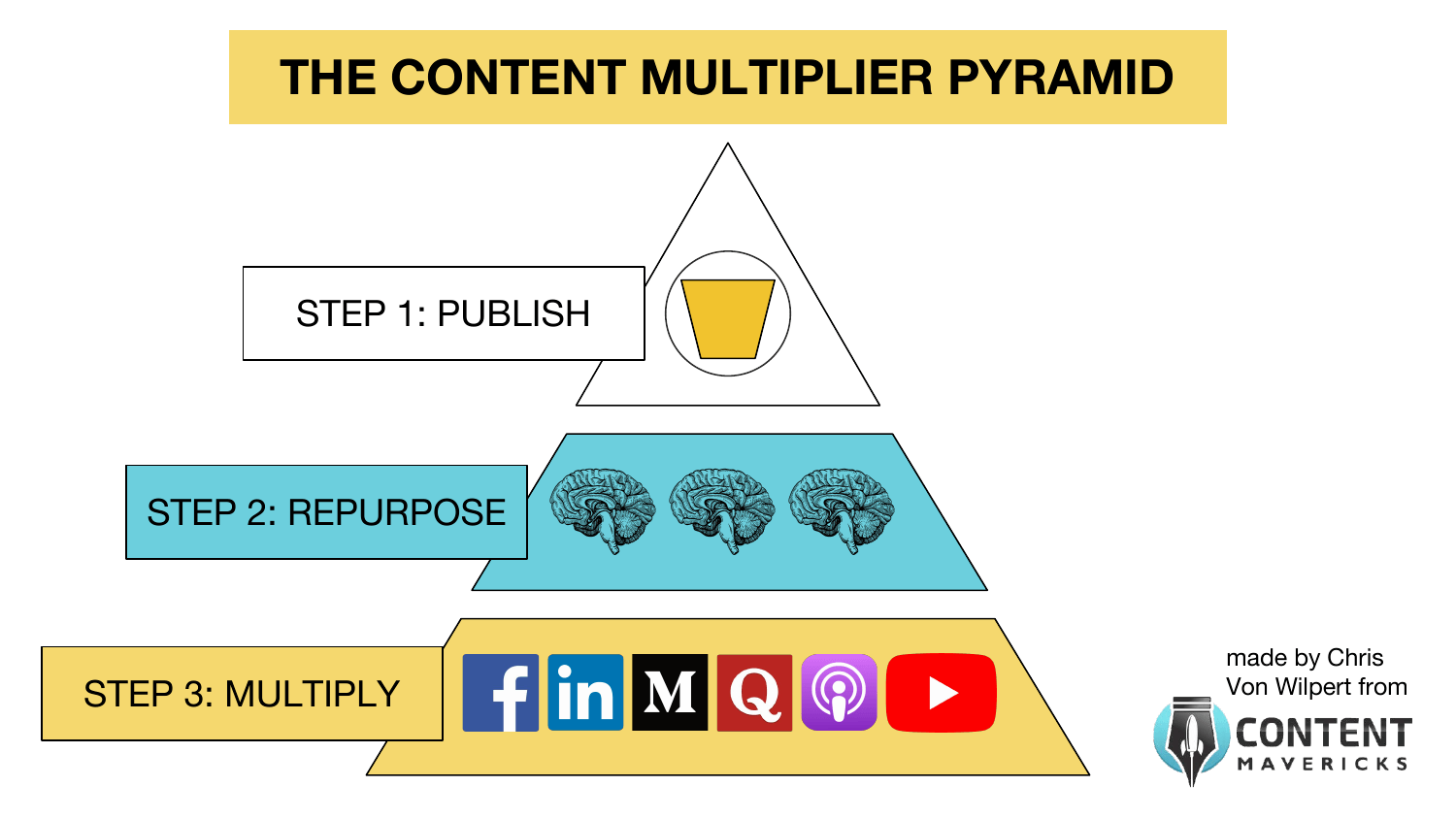
Note: You can’t use the Content Multiplier Pyramid to repurpose your content, post on different distribution platforms and instantly get massive traffic. That’s a myth promoted by online celebrities who already have large followings on the platforms they distribute on.
Just like a human, every platforms algorithm has biases, heuristics and tendencies that rule its behavior and decisions.
When you repurpose your content, you need to know how to leverage those biases to position your content to get max organic reach from the algorithm.
Below I’m going to show you my #1 method for strategically leveraging the algorithm on five different platforms to get max content reach with a small following <5,000 fans.
LinkedIn Article
My #1 method for multiplying content on LinkedIn is using a viral loop that asks people to comment, like this:

If your content is remarkable people will be happy to reciprocate with a comment.
Asking people to comment plays to LinkedIn’s engagement bias.
Whenever someone comments, LinkedIn shows this message to that person’s followers in their feed:
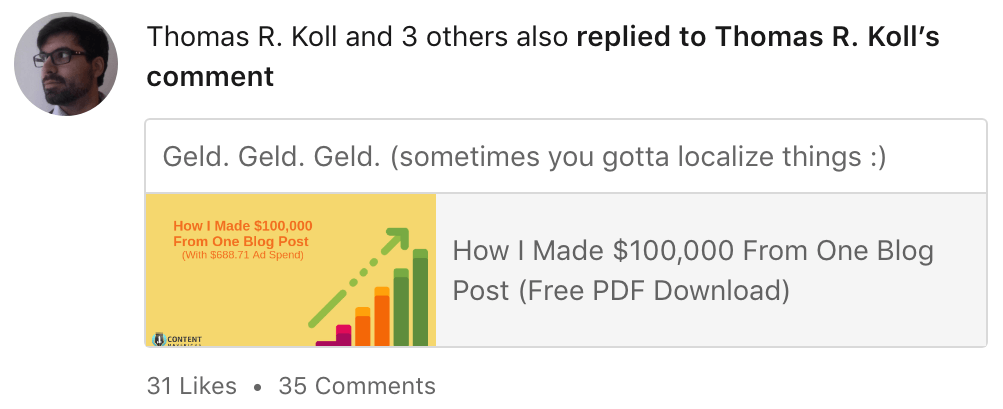
Best practices for a high traffic LinkedIn Article are:
- You ask people to comment and include a link to your content at the top of the article (like my example above).
- You use bullet points to tell people exactly what they will get (pictured below is an example of seven bullets points I used.)
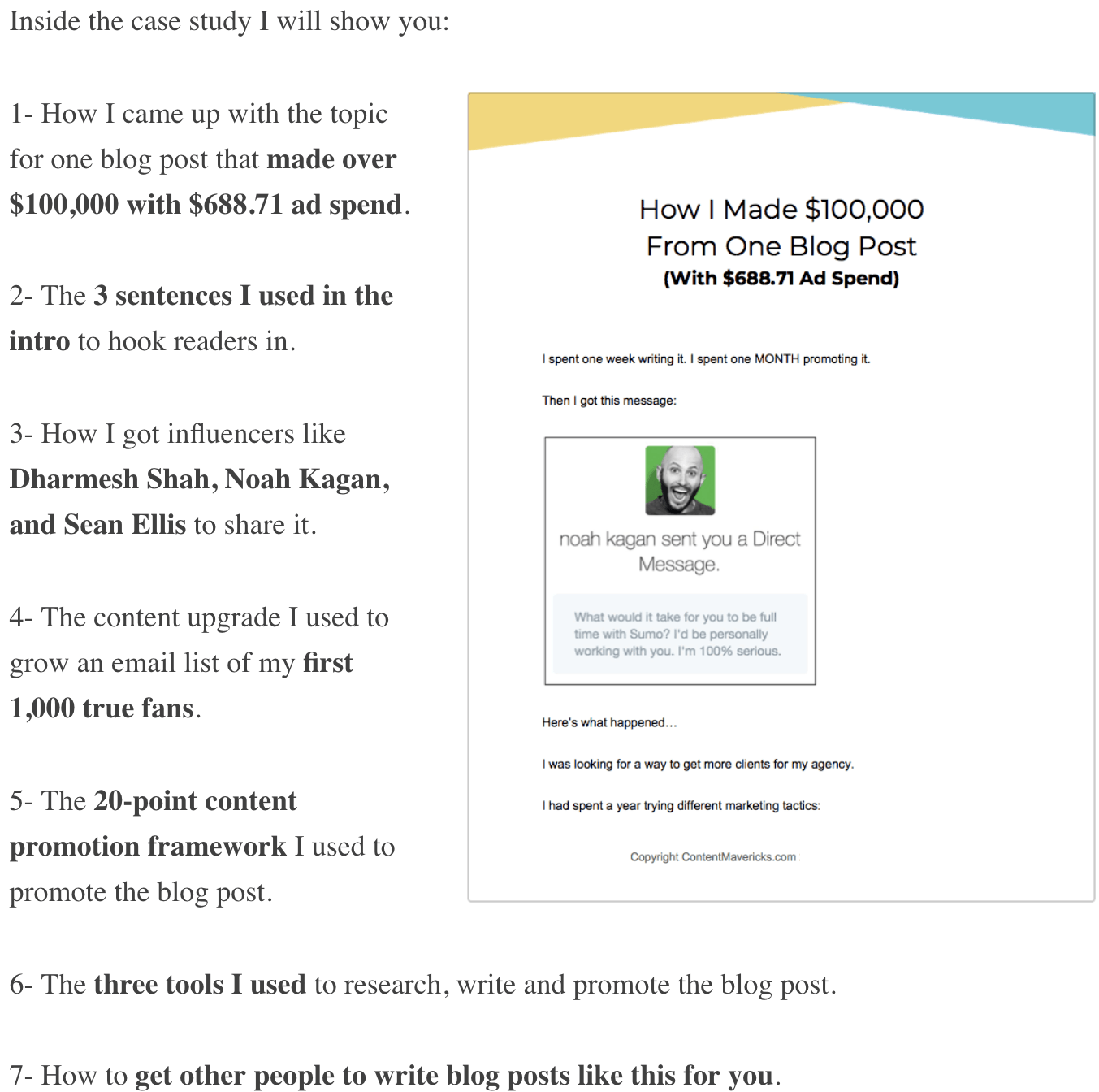
3. You ask people to comment and include a link to your content at the bottom of the article (pictured below is an example of how I did it.)
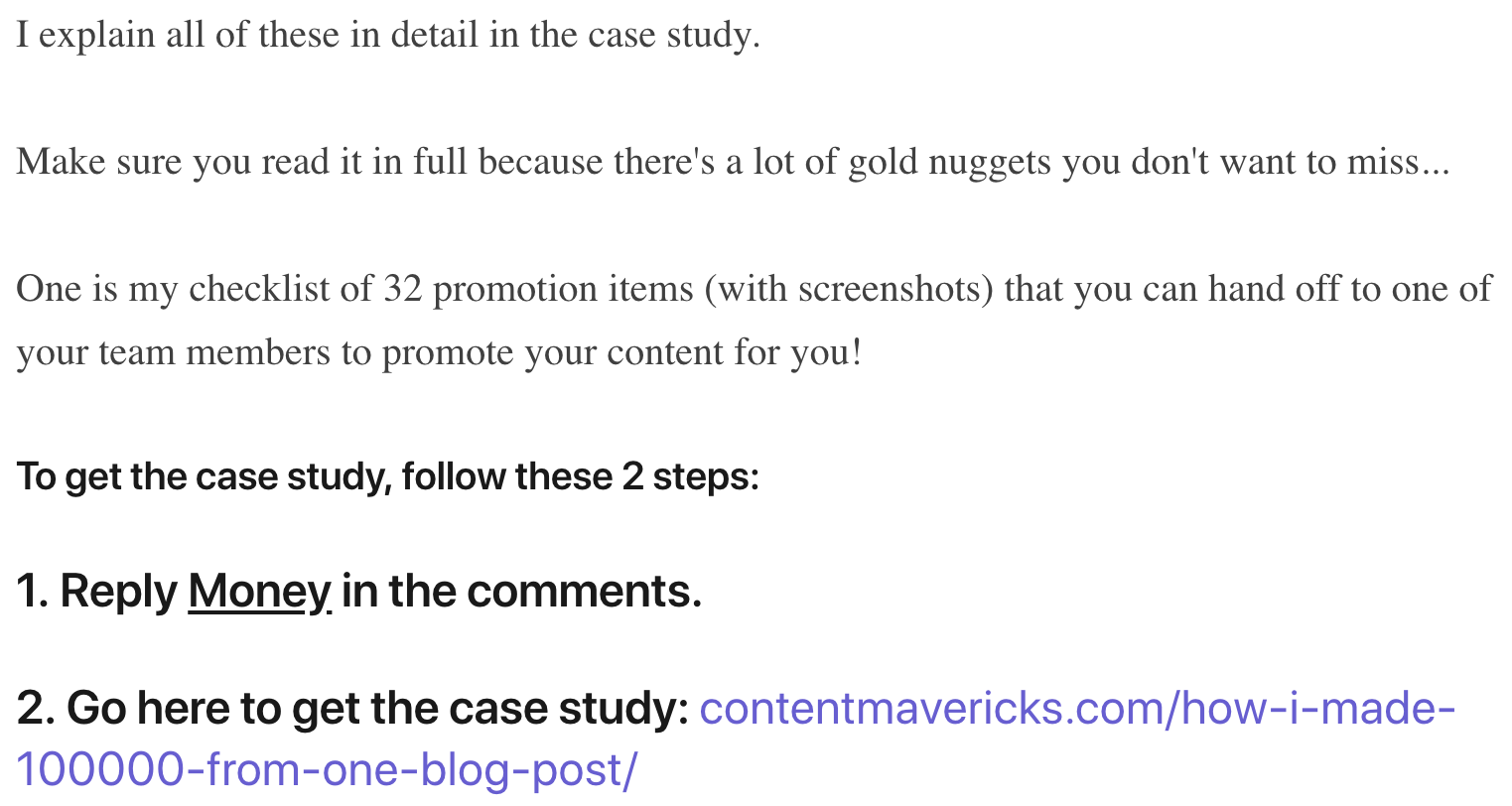
Here are the best practices to follow for your next LinkedIn Article:
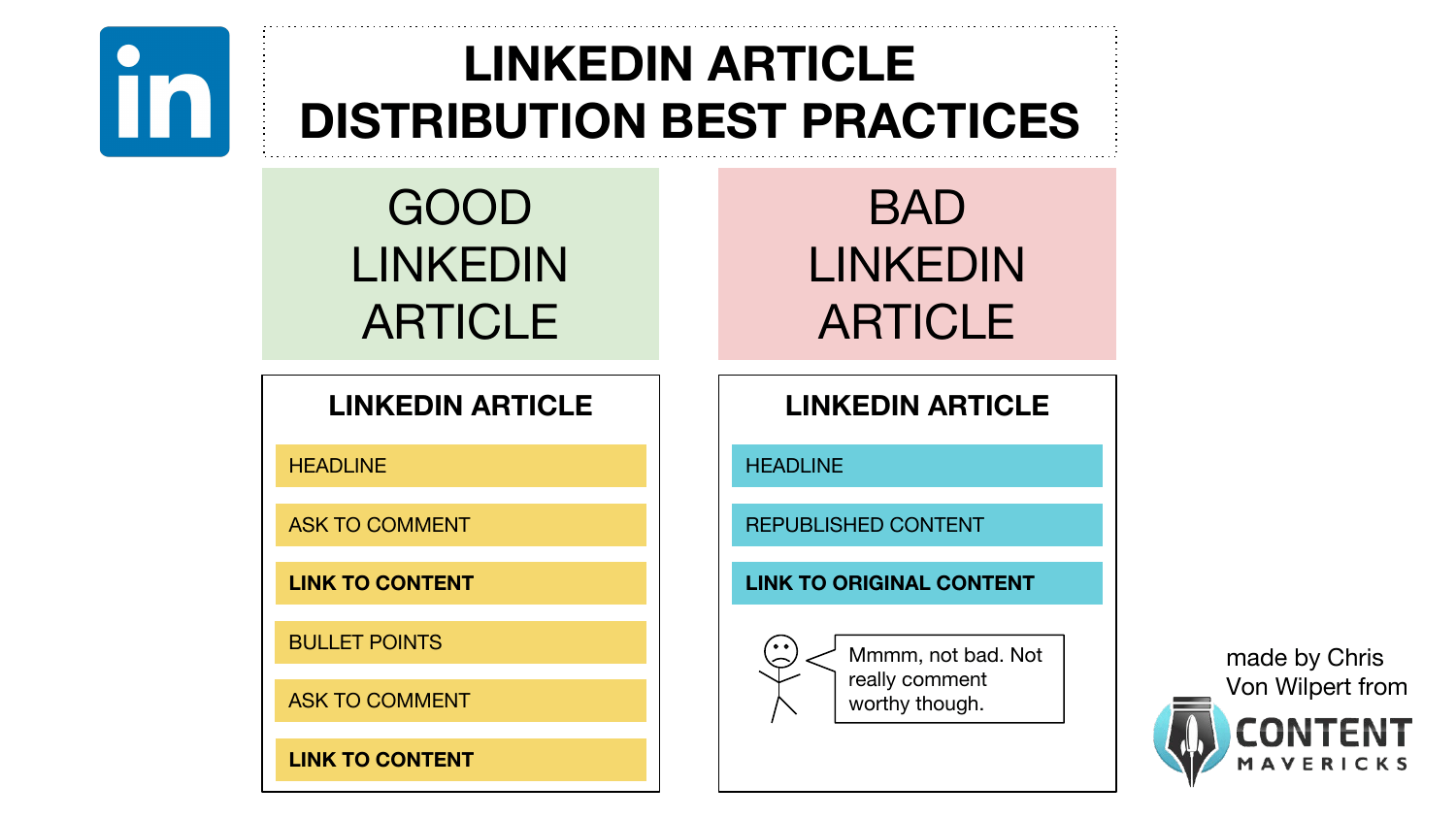
Facebook Video
My #1 method for multiplying content on Facebook is using a 30-90 second teaser video to tell people what they’re going to see in the post, like this:
Using a short 30-90 second video plays to Facebook’s engagement bias.
The short length helps hold someone’s attention on your post in their Facebook feed, so they then engage (like/comment/share) after watching.
That engagement then leads to Facebook giving your video more reach.
Best practices for a high traffic Facebook video are:
- You keep it short (30-90 seconds).
- You tell people what they’ll see when they access the full piece of content.
- You give clear next steps on where to access the full piece of content.

YouTube Video
My #1 method for multiplying content on YouTube is using YouTube Search Suggest topics to make a video related to the topic that gets search volume in YouTube, like this:

Once I’ve identified a topic with YouTube traffic potential, I’ll then make a YouTube video about it, like this:
To optimize traffic to the video I play to YouTube’s audience retention bias.
YouTube wants people to stay on the platform so they click on ads.
If you help them with that goal by keeping your video viewers on their platform longer, their algorithm will promote your video.
Best practices for a high traffic YouTube video are:
- You make sure it’s a meaty 10+ minute video.
- You start your video with a summary of the topic, then jump into the meat of the content straight away.
- You use open loops (aka give people a teaser of what’s coming up in the video) every 2-3 minutes to keep the viewers attention.
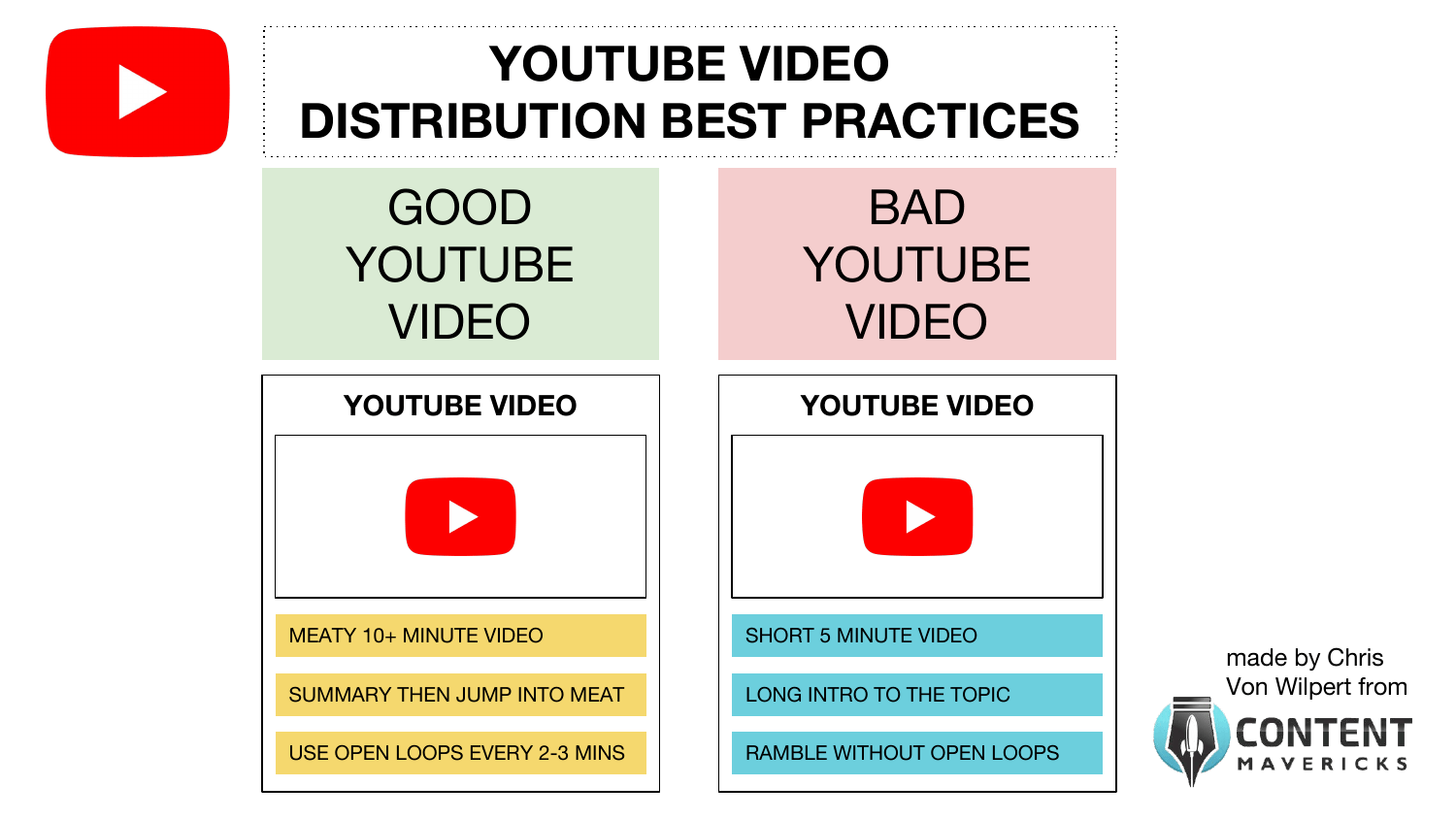
Medium Story
My #1 method for multiplying content on Medium is using a big idea to transform a piece of content into an interesting story, like this:

That post above has the highest read ratio of all my long-form articles on Medium, with the Medium platform driving 27% of the 3,100 views to the post.
Using a headline with a counterintuitive angle plays to Medium’s unique perspective bias.
When I analyzed all my Medium stories, I found that Medium was giving more traffic to stories with a unique perspective on a topic.

On Medium it doesn’t matter if your story is short, long, serious, funny, reported or opinionated. If you can showcase smart, insightful thinking through your writing, Medium’s algorithm will help your story spread.
Best practices for a high traffic Medium story are:
- Give your story a thought-provocative, curiosity-filled headline. Some proven, successful Medium headlines with 10k+ claps include:
- 8 Things Every Person Should Do Before 8AM
- 25 Things About Life I Wish I Had Known 10 Years Ago
- How Quitting My Corporate Job For My Startup Dream F*cked My Life Up
- Start and end your article with a story.
- Include practical takeaways inside the body of the story.

Quora Answer
My #1 method for multiplying content on Quora is using an organic traffic hack on SEMRush to find a Quora answer on my topic that’s in position 1-10 on Google, that also has greater than 100 search volume, like this:
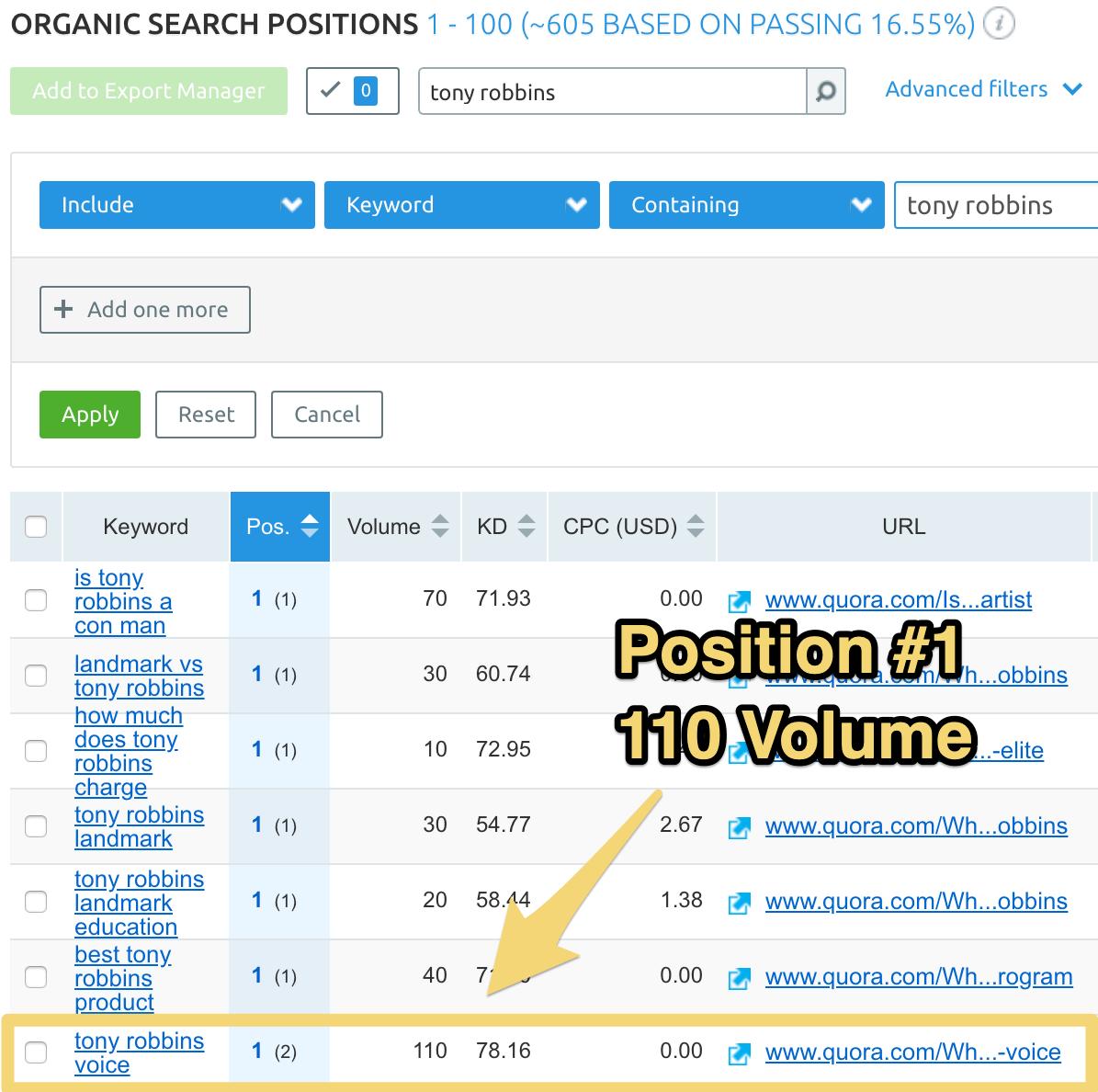
I go to SEMrush > Organic Research > search for quora.com > then do an Advanced Search for the topic of my content.
Once I find a Quora question that meets my criteria, I answer it:

If you win the answer, you have potential to get ongoing traffic.
And if you follow my best practices, you can get your answer featured in the Quora Digest like my answer above. Quora Digest is an email of ~10 answers Quora sends to their users based on their interests, people they follow, and an answers popularity.

Instead of wasting time answering random answers, you now have a strategy to only answer the best ones related to your business where you'll get the biggest bang for your buck.
To get the most upvoted and viewed answer I play to Quora’s multimedia bias.
Instead of stuffing my answers with text and links, I lead with value, and use multiple media (text/images/video) to give the best answer.
Best practices for a high traffic Quora answer are:
- You write a unique, well-thought out answer (30 min - 1 hour goes into answering it).
- You use text, images, and sometimes even video.
- You link to your piece of content for people who want to go more in-depth into your answer.
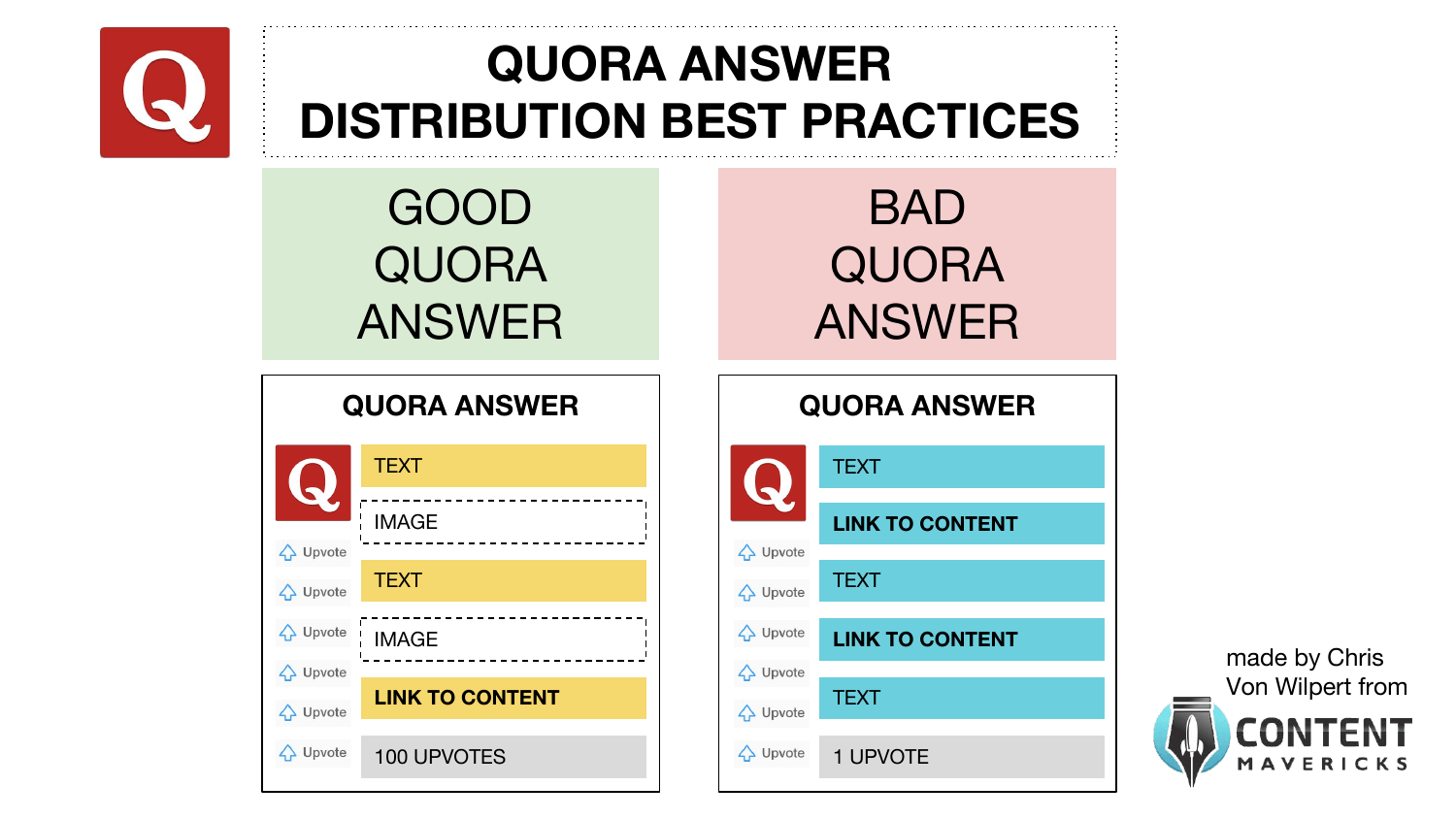
Every platform has its own algorithm.
And every algorithm has its own biases.
Using the methods I’ve taught you above, you can play to the algorithms strongest bias so your content gets more reach on every platform.
Here’s a recap of each one:
- Engagement bias (Facebook/LinkedIn)
- Audience retention bias (YouTube)
- Unique perspective bias (Medium)
- Multimedia bias (Quora)

Want my blueprint to get more traffic to your content using free traffic multipliers?
Download my Content Distribution Checklist with the list multipliers, social media multipliers, and content multipliers I use. Inside you’ll get links to examples for every free traffic multiplier.
Now you know how to use list multipliers, social media multipliers, and content multipliers, it’s time to start using paid traffic multipliers to distribute your content.
Step 3: Use Paid Traffic Multipliers To Manufacture Virality, Amplify Your Top Performing Content, And Reach Thousands Of New Fans
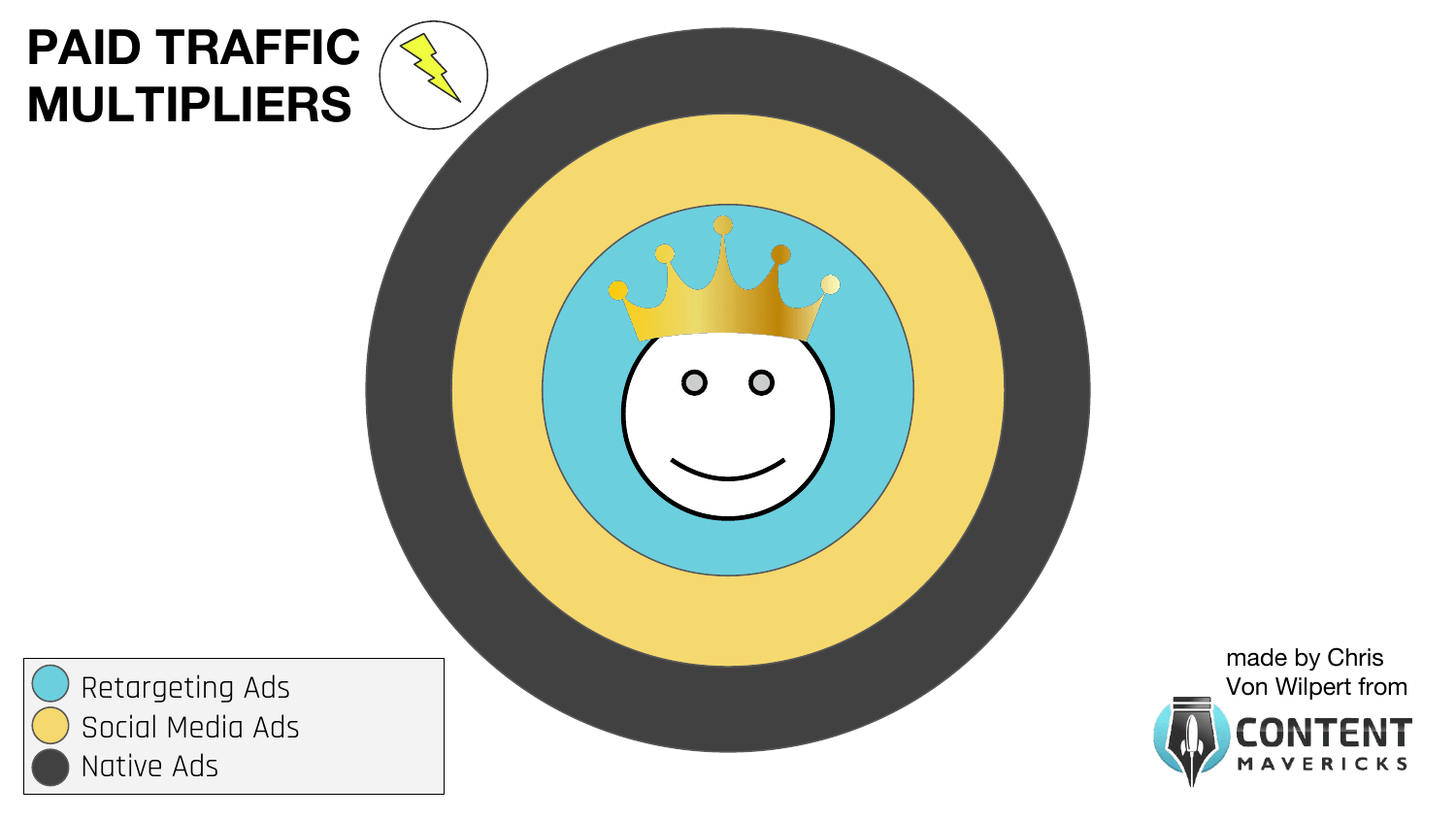
Retargeting Ads
Retargeting ads are the ads you use to retarget your website visitors with your content. This is where you retarget your content across:
- Outbrain
I call these “The Fab Four” because although there are other ad networks you can retarget on, I can’t think of a single business who’s audience doesn’t visit sites on those four channels.
These are also the four platforms I used in the ski slope strategy to build a content sales funnel that brought in 1,070 recurring revenue customers in one year.
Below I’m going to show you the top example of how I retarget website traffic to top of funnel content on The Fab Four, and the best practices for each.
My #1 method for retargeting on Facebook is using a Post engagement ad, like this:
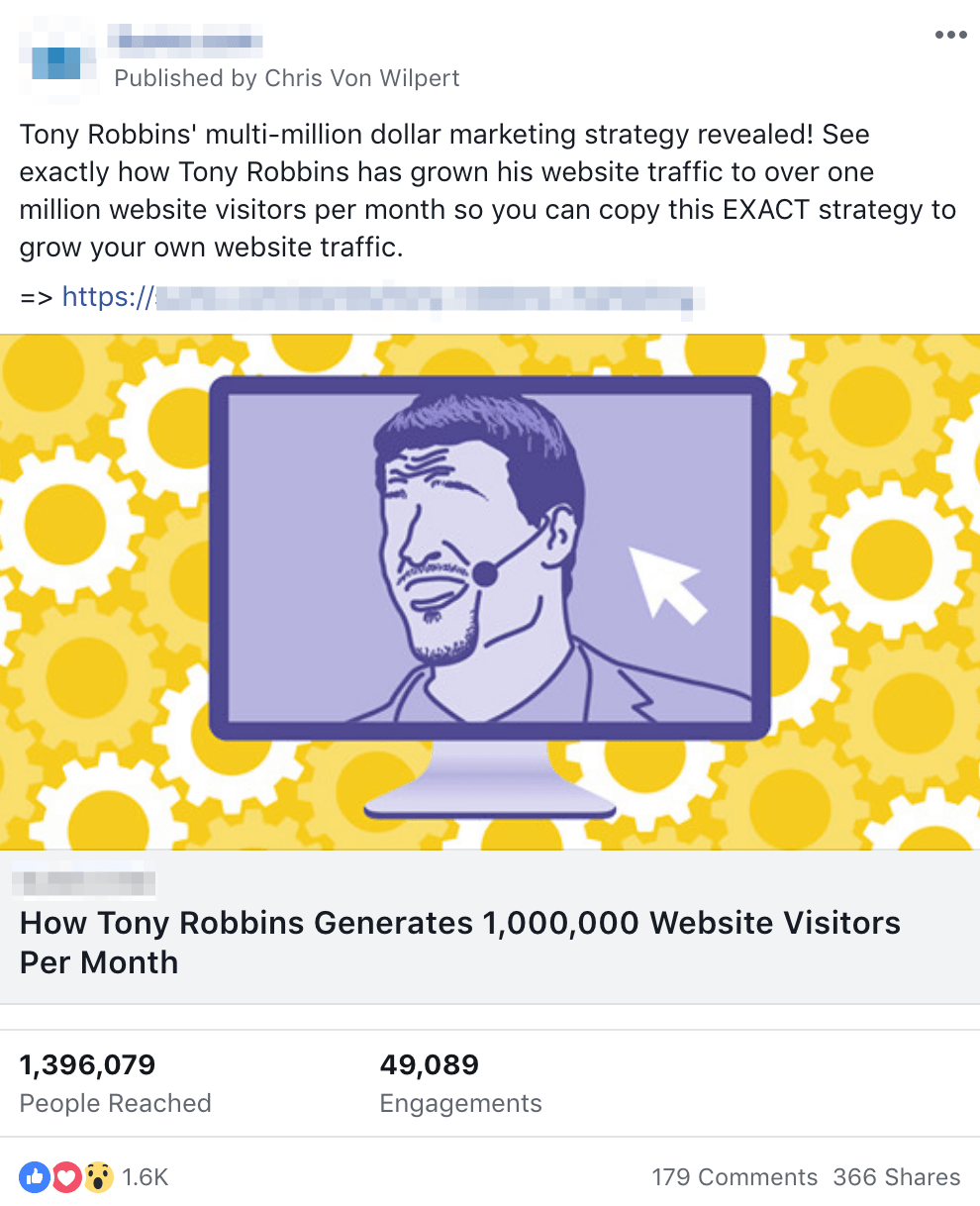
I run the post engagement ad across desktop and mobile devices (excluding Instagram) and target people in the Big 4 (Australia, UK, US, and Canada).
My goal is to build up social proof (likes/comments/shares) before using the same ad to target cold traffic audiences.

Best practices for a high click-through rate Facebook retargeting ad are:
- You clearly explain what the piece of content is about in two sentences.
- You put the link in the description on it’s own line.
- You use an image with high click-through rate elements (diagonal lines/circles/recognizable objects/high contrast colors).

My #1 method for retargeting on Twitter is using a Tweet engagements ad, like this:

Similar to Facebook, I run the tweet engagements ad across desktop and mobile devices and target people in the Big 4 (Australia, UK, US, and Canada).
My goal is to build up social proof (likes/retweets/replies) before using the same ad to target cold traffic audiences.
Best practices for a high click-through rate Twitter retargeting ad are:
- You use a headline with curiosity and benefits.
- You use a Twitter card to increase click-through rate so when people click the image, they go straight to your piece of content.
- You use an image with high click-through rate elements (diagonal lines/circles/recognizable objects/high contrast colors).
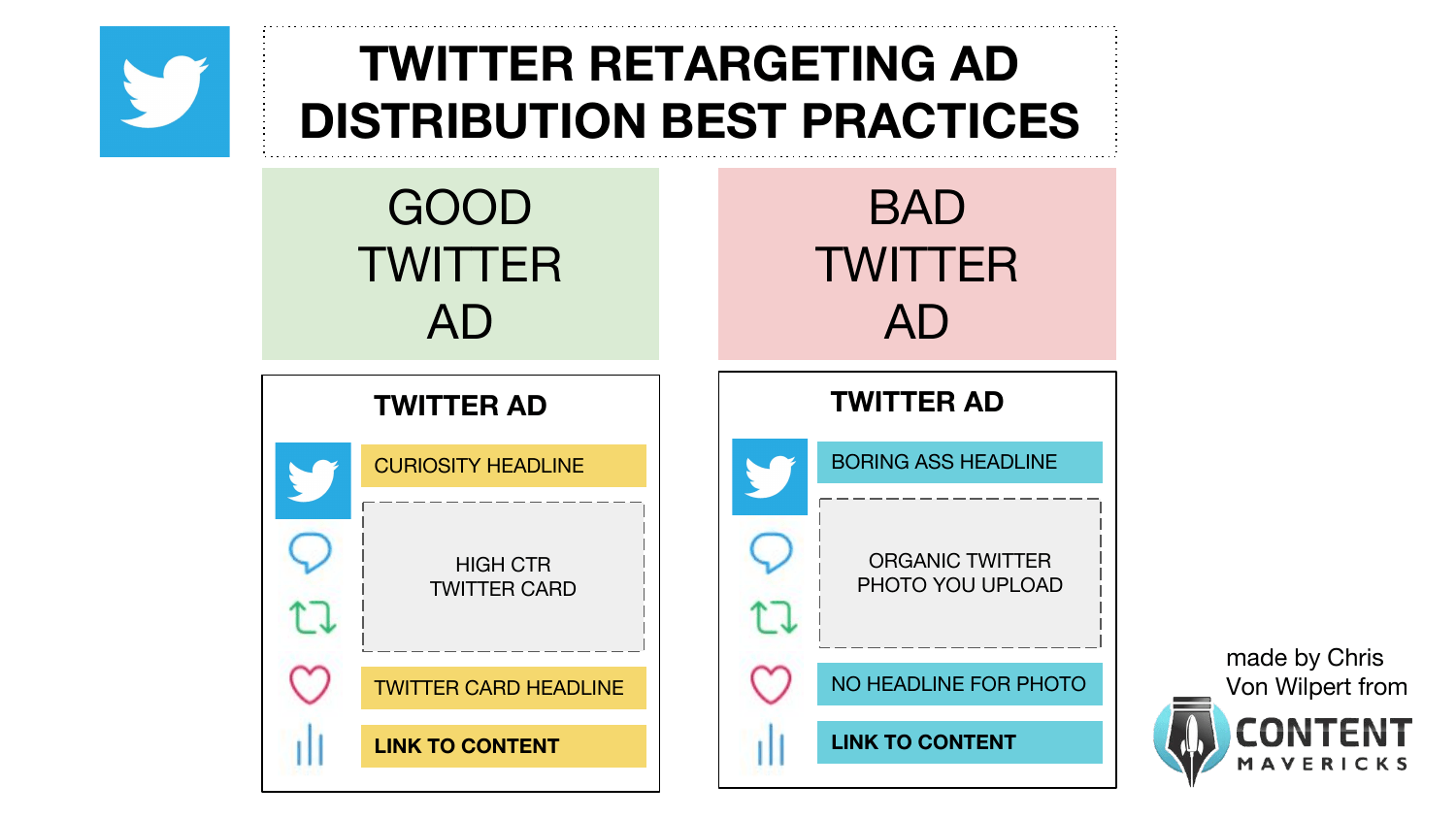
My #1 method for retargeting on Google is using a Website traffic display ad, like this:

I run the ad across desktop and mobile devices and target people in the Big 4 (Australia, UK, US, and Canada) with my bidding set to maximize clicks.
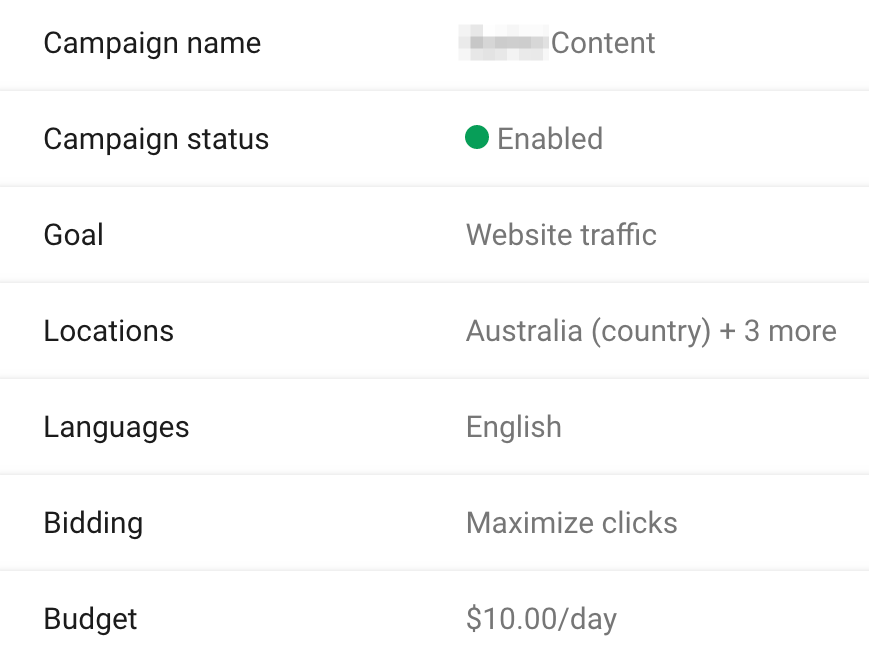
This gets me cheap clicks from people browsing websites online that are part of Google’s display network, which is the biggest ad network in the world (even bigger than Facebook).
Best practices for a high click-through rate Google display retargeting ad are:
- You use a 300x250 dimension Google display ad (because this is the most common ad unit, so you will get the most clicks without getting overwhelmed having to create 100s of banner sizes.)
- You use a short four word headline with curiosity and benefits, a one line description below the headline, your company name on the bottom left, and blue underlined “Learn more” text on the bottom right.
- You use an image with high click-through rate elements (diagonal lines/circles/recognizable objects/high contrast colors).

Outbrain
My #1 method for retargeting on Outbrain is using a content amplification ad, like this:

I run the ad across desktop and mobile devices and target people in the Big 4 (Australia, UK, US, and Canada) with my bidding set to maximize clicks.
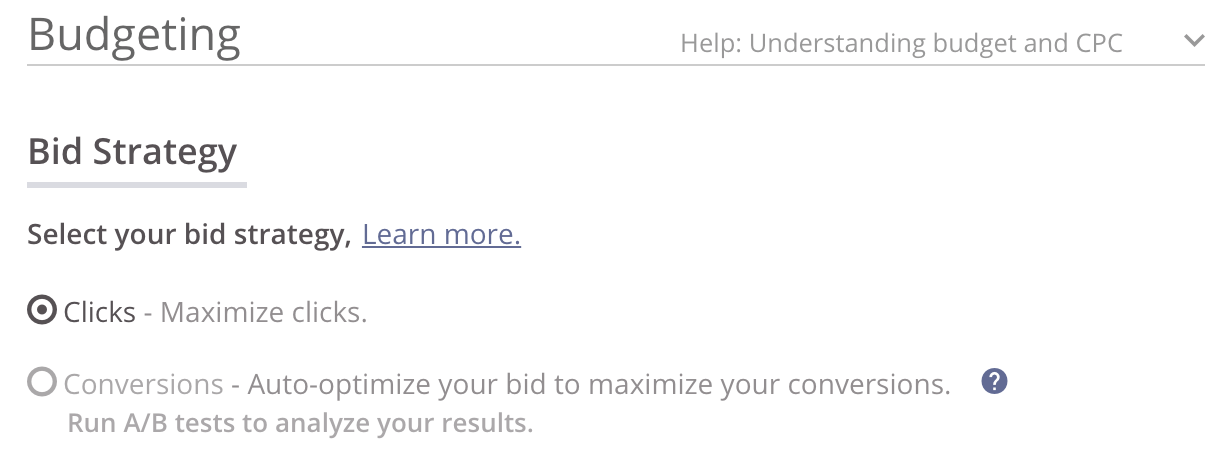
This gets me cheap clicks from people browsing large publications like CNN, Fast Company, Wired and other niche publications I can’t get access to with Facebook, Twitter, and Google’s ad inventory.
Best practices for a high click-through rate Outbrain retargeting ad are:
- You create three headlines for your piece of content (one is a list with an odd number, one is a question, and one calls out your target audience.) See my screenshot below for examples of the types of headlines that work best.

2. You use a 1200x800 dimension ad image with a lifestyle photograph, close-up picture of people faces, or an image of your target audience that matches the content.
3. You let Outbrain’s optimization algorithm find your highest click-through rate headline<>image ad combination.

Now we’ve covered The Fab Four (Facebook/Twitter/Google/Outbrain) retargeting ads you can use, let’s talk about the next paid traffic multiplier you can use to distribute your content: social media ads.
Social Media Ads
Social media ads are the ads you use to target cold traffic on social media with your content. This is where you target cold traffic across:
You can run ads on other platforms like LinkedIn, Instagram, Quora, YouTube etc. However what cold traffic social media ads really thrive on is SOCIAL PROOF.
If you’ve followed my strategy this far, you would have already built up social proof on one Facebook and Twitter post using retargeting ads.
Now it’s time to double-down and amplify those posts to a cold traffic audience using something I call The Thumb Stop Effect.

The thumb stop effect is deeply rooted in human psychology.
Humans are social creatures. When presented with overwhelming social proof they get curious and can’t help but to see what’s going on. This leads to fast, impulse buy (and ad click) decisions.
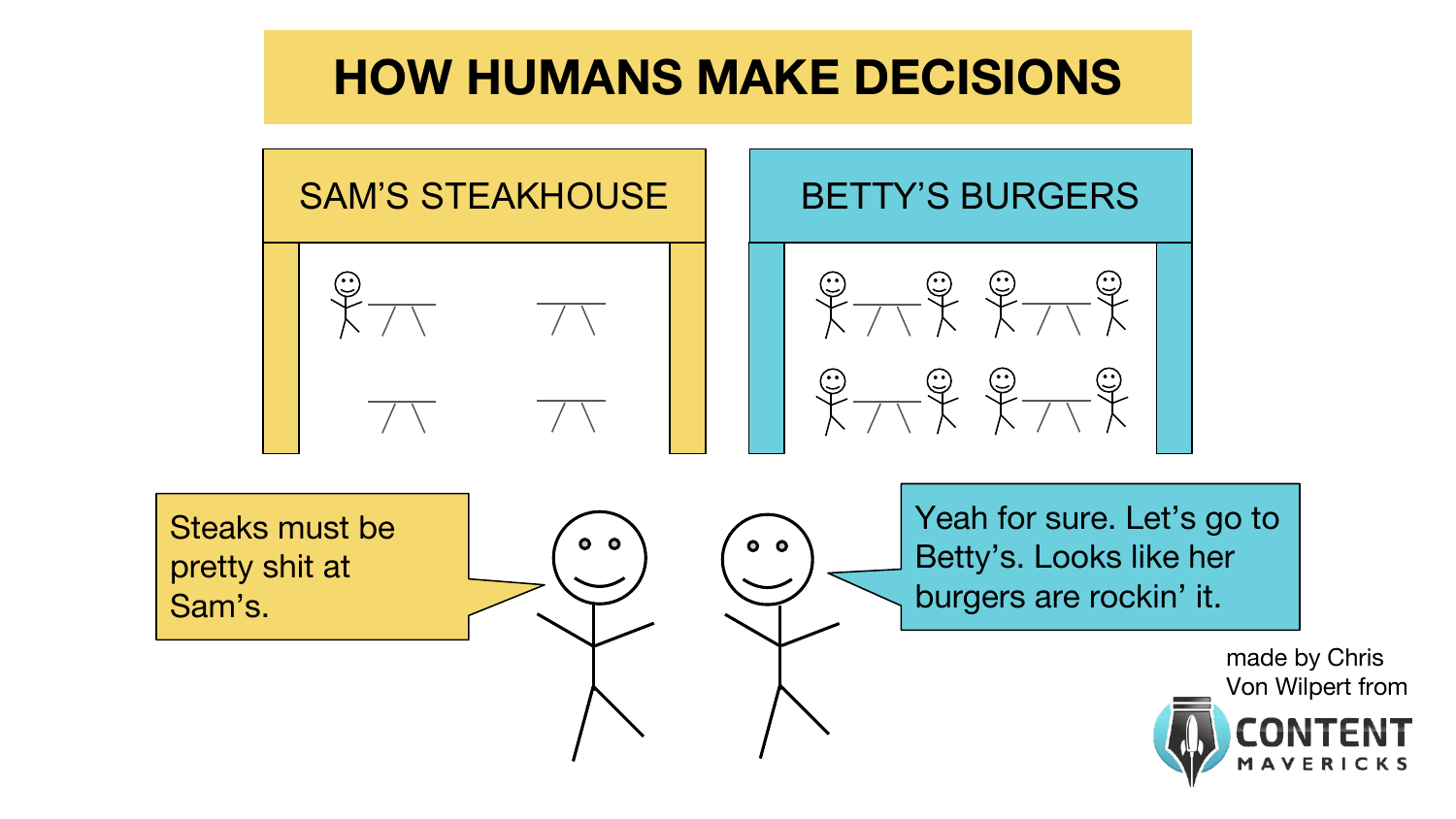
Below I’m going to show you how you can influence human decisions by creating the thumb stop effect for your own social media ads, and the best practices for each.
My #1 method for running social media ads on Facebook is using a Mobile link click ad, like this:

When I set up the ad, I do two things:
- Pick the Use Existing Post option inside the ad settings.
- Select the retargeting ad I’ve already built up social proof on.

If you can’t find your retargeting ad from the drop-down menu, you can enter the post ID. Here’s where you find it, when viewing your ad:

To really scale my content on Facebook I target broad Interests directly related to the topic of my content. Here’s an example from my ad:

I only target mobile devices, using a lowest cost bid strategy:

This strategy gets me cheaper clicks on my cold traffic than most people are able to get with their warm retargeting traffic.
I then turn that traffic into customers on desktop devices using The Everywhere Effect Content Sales Funnel.

=> Click here to learn how this content sales funnel works.
Best practices for a high traffic Facebook social media ad are:
- You copy the post ID from your retargeting ad that has social proof built up.
- You target an audience closely related to your piece of content.
- You target mobile devices where clicks are cheaper, so you can later retarget on desktop devices where you are more likely to make a sale.
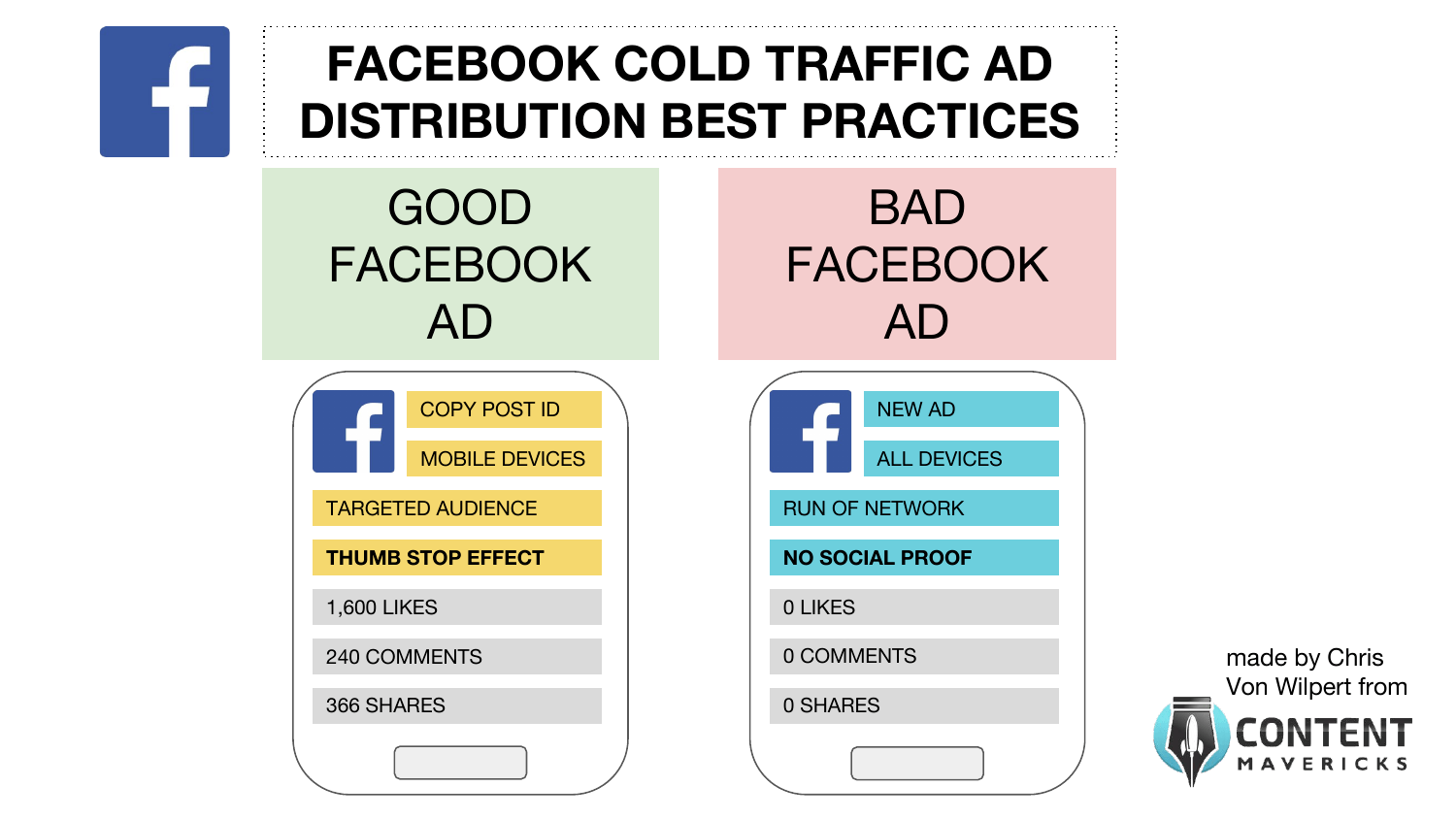
My #1 method for running social media ads on Twitter is using a Mobile website clicks ad, like this:

When I set up the Creatives for the ad, I select the retargeting ad I’ve already built up social proof on (this is the same as using the same post ID on Facebook.)

To really scale my content on Twitter I target broad Follower look-alikes directly related to the topic of my content. Here’s an example from my ad:

I only target mobile devices, using an automatic bid strategy.
Similar to Facebook, this strategy gets me cheaper clicks on my cold traffic than most people are able to get with their warm retargeting traffic.

I then turn that traffic into customers on desktop devices using The Everywhere Effect Content Sales Funnel.
Best practices for a high traffic Twitter social media ad are:
- You use the same Tweet from your retargeting ad that has social proof built up.
- You target an audience closely related to your piece of content.
- You target mobile devices where clicks are cheaper, so you can later retarget on desktop devices where you are more likely to make a sale.
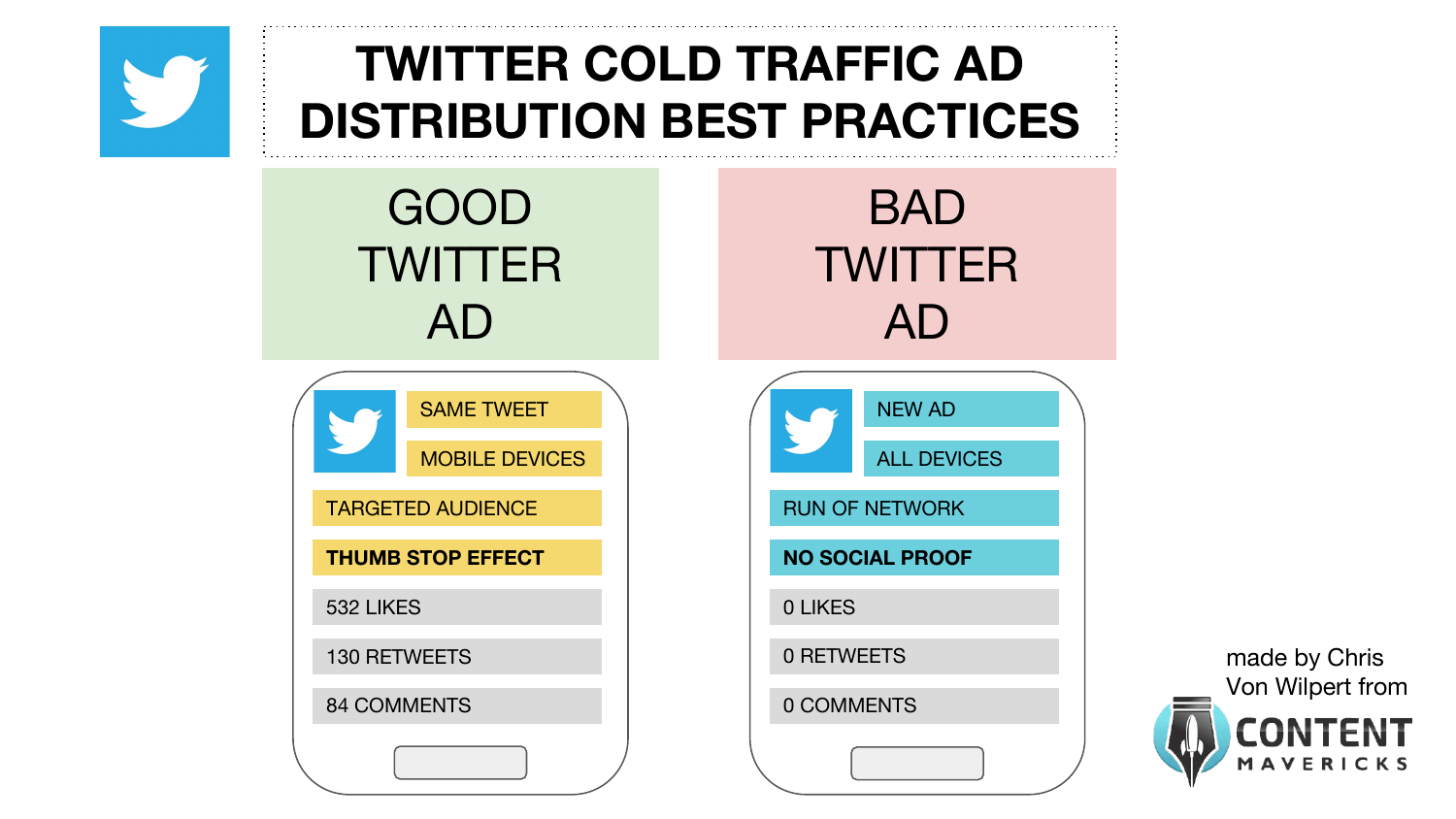
Now you’ve seen how I leverage social proof to run high traffic social media ads with cheap click costs, let’s talk about the last paid traffic multiplier you can use to distribute your content: native ads.
Native Ads
Native ads are the ads you use to target cold traffic to your content on the world’s leading publishers like Time, Forbes, Wall Street Journal, New York Times, and USA Today.
You set up the ads on native ad platforms like:
- Outbrain
- Taboola
- Sharethrough
The key with native ads is to connect your ad with the media outlet and your target audience. That’s when you reach native ad nirvana, where your click-through rate skyrockets, your cost per click decreases, and more people share your content.
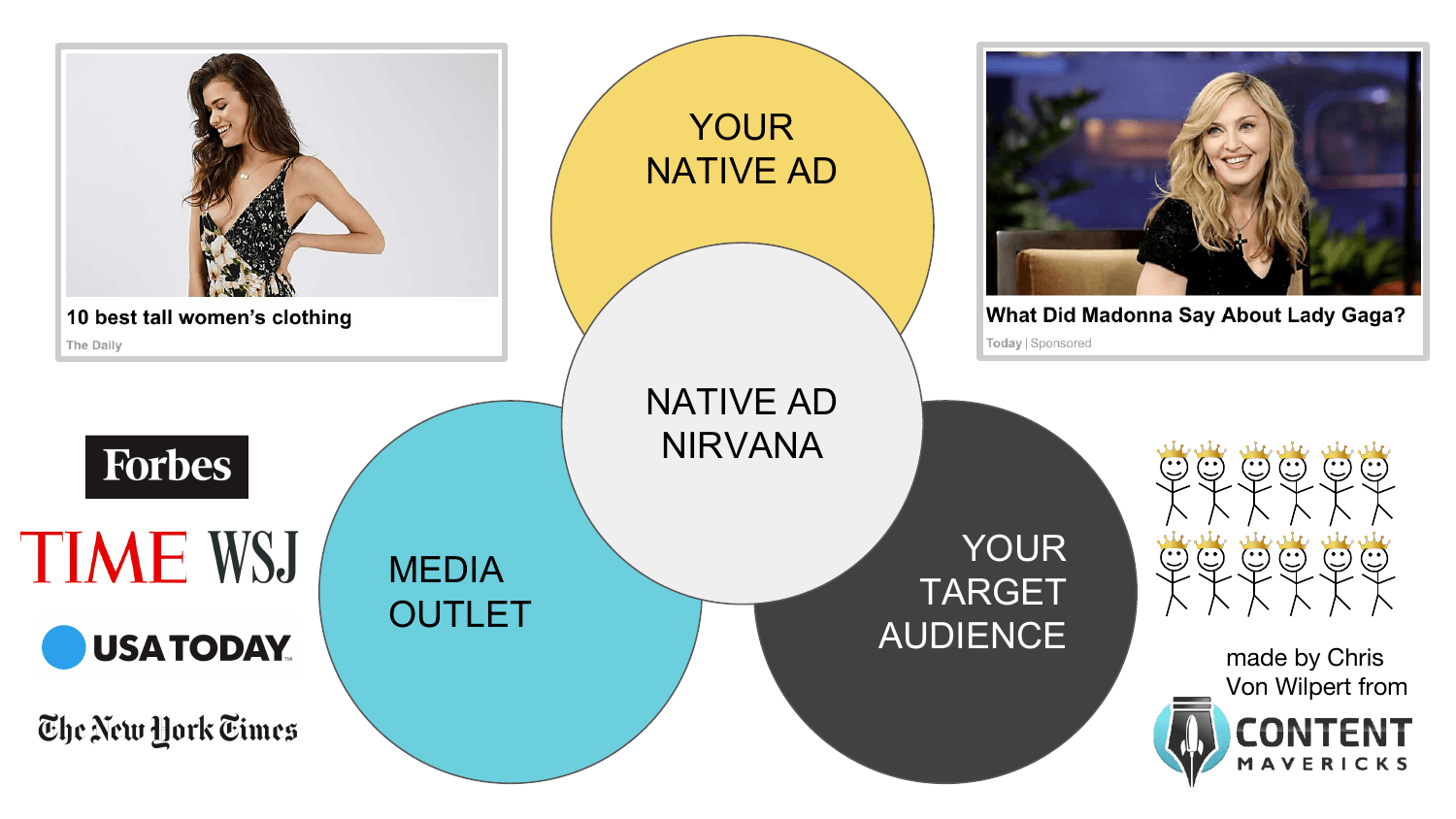
For many businesses targeting niche markets, native ads won’t be a great fit. For example, if you want to target Shopify business owners with native ads, you can’t do that.
I’m not saying native ad networks don’t have targeted traffic, they do. But they don’t have the deep targeting options Facebook and Twitter do.
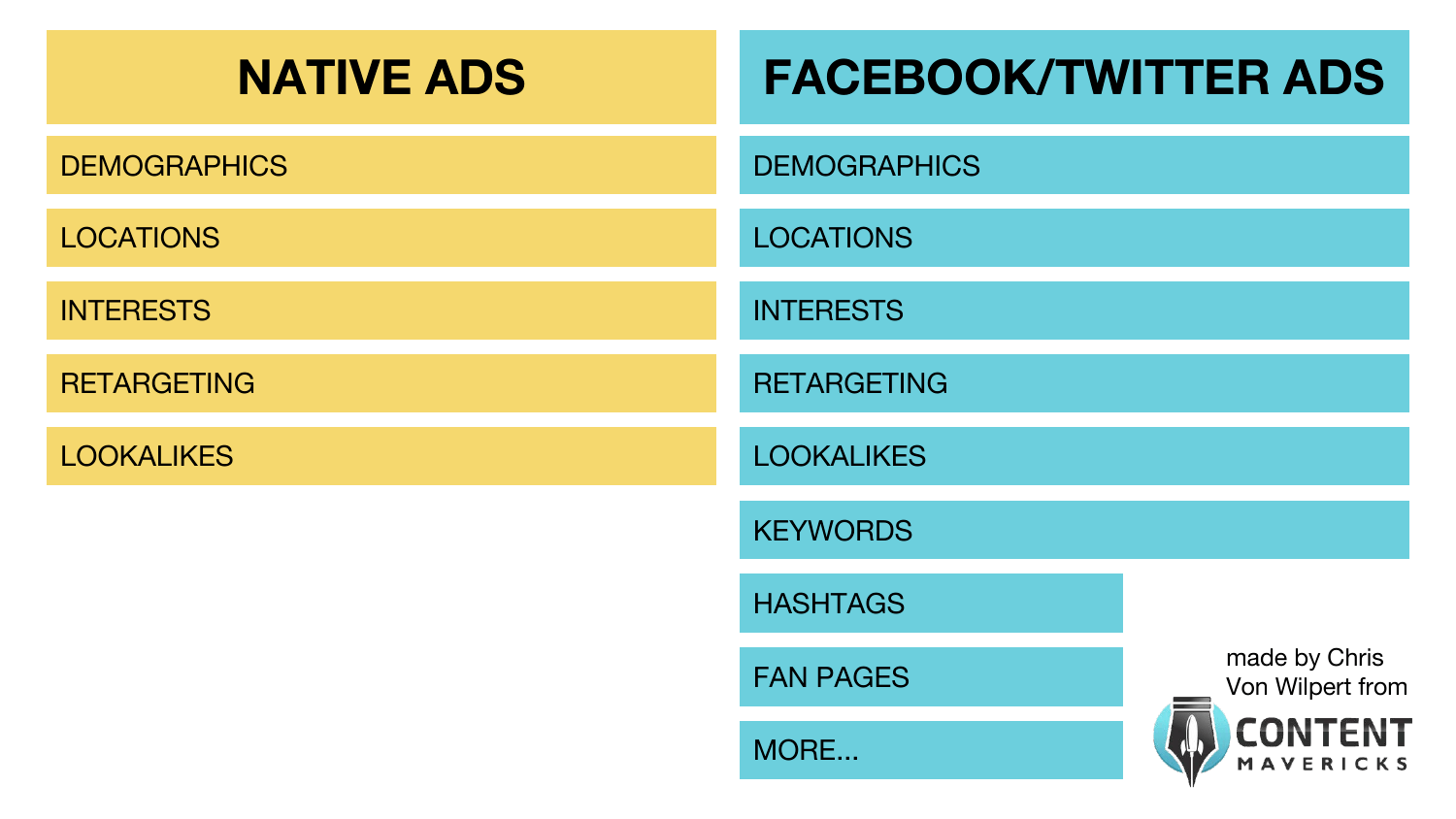
That image above is why I use Facebook and Twitter for the bulk of my paid content distribution.
If I want to target a broad audience, below is an example of how I run native ads on Outbrain.
Outbrain
My #1 method for amplifying content on Outbrain is using an Amplify campaign, like this:

To increase my chances of success, I:
- Duplicate my retargeting campaign.
- Pause all the losing ads.
- Keep the winning ad running with the highest click-through rate.

I then remove the retargeting audience segment from my campaign, and target one broad interest. In the below example I’m targeting people interested in Marketing.

If I want to target more than one interest, I create a new campaign for each interest I target, otherwise I won’t know which interest is causing the good or bad conversions.
If you have a mass appeal offer you can create one campaign that targets no interests aka “run of network.” Set a max CPC you’re comfortable with, and let the native ad networks optimization algorithm do its job.

Native ad algorithms are pretty good at matching your content with the right audience with run of network campaigns. They were built to distribute content!
On Outbrain, a run of network campaign in the United States will get you a potential reach of 181 million across their publisher network (compared to 850,000 if you just add the Marketing interest like I did above.)

Best practices for a high traffic native ad are:
- You aim for 0.50% or higher CTR.
- You use a list with an odd number, question, or call out your target audience in the headline.
- You use a 1200x800 dimension ad image with a lifestyle photograph, close-up picture of people faces, or an image of your target audience that matches the content.
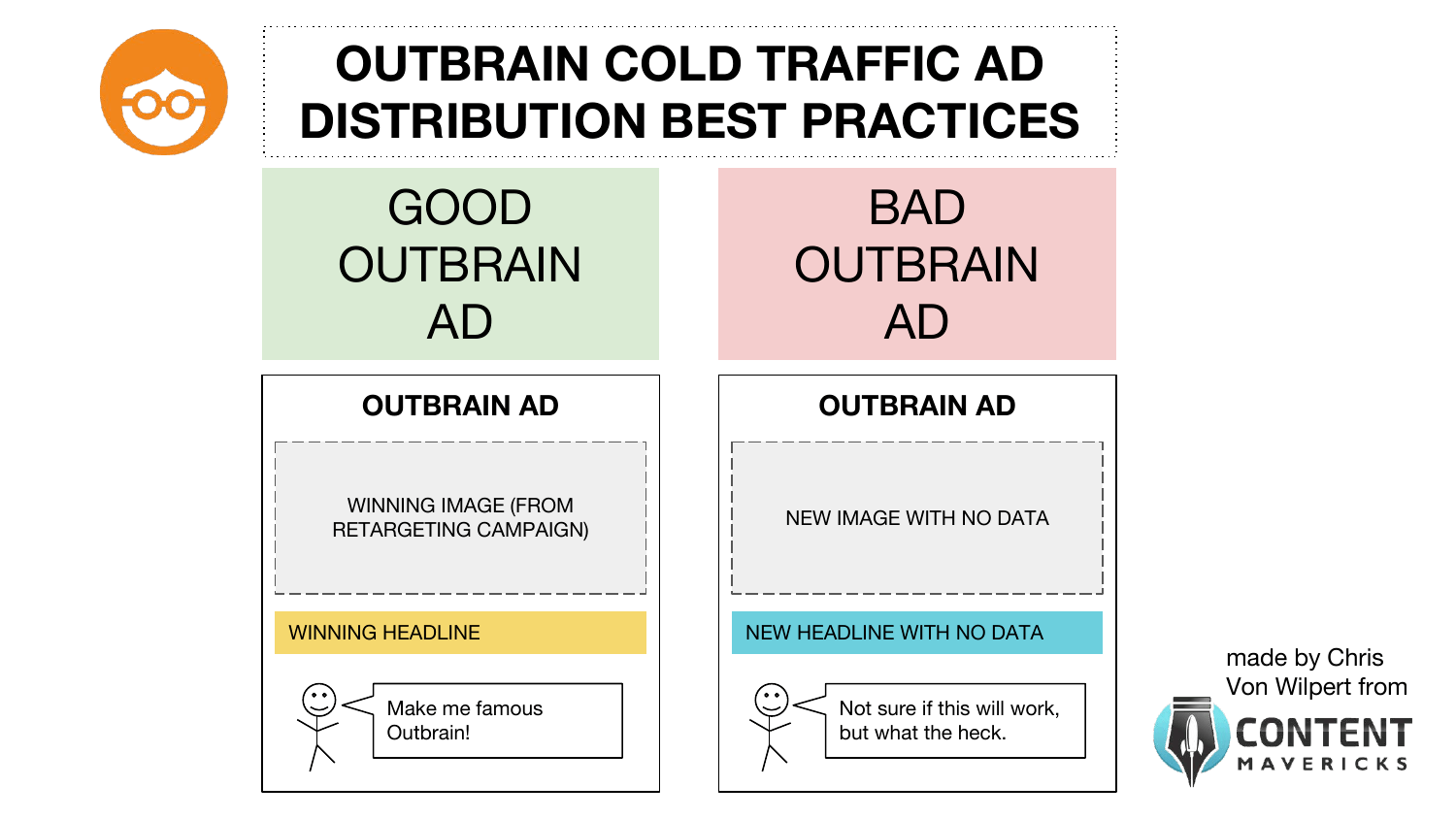
Want my blueprint to get more traffic to your content using paid traffic multipliers?
Download my Content Distribution Checklist with the retargeting ads, social media ads, and native ads I use. Inside you’ll get links to examples for every paid traffic multiplier.
Now You Try It
Are you gonna be like Frank or Freddie?

If Freddie’s your man, I’ve put together a step-by-step content distribution checklist to help you get started.
So you don’t get overwhelmed, I recommend you:
- Download the checklist.
- DELETE any items you don’t think are a good fit for your business.
- ADD any items you think are a good fit for your business.
If you’re just starting out with a small site: Focus on building your audience while using the free traffic multipliers in the checklist.
If you’re more established with an existing audience: Focus on mastering one of the paid traffic multipliers to amplify your reach.
Doing one thing, is more important than doing everything.
As you drive more traffic to your content, more and more people will start linking to it, and naturally organic SEO traffic will start to kick-in (if you've optimized your content correctly).
This is how you can get a good balance of 50% paid — 50% organic traffic going to your content long term.
Don't have time to distribute your content?
Our partners Repurpose House can turn any piece of content you have (blog article, video, pdf, or podcast) into different sized videograms, thumbnails, image quotes, and promo images for Facebook, Instagram, Twitter, YouTube stories, and more.
Use discount code CONTENTMAVERICKS to get 10% off your first month.
Now I’d like to hear from you:
Which traffic multipliers are you going to try first?
Are you starting out, and going to focus on free traffic multipliers?
Or are you ready to take your content promotion game to the next-level with paid traffic multipliers?
Either way, let me know by leaving a quick comment below right now.

